How To Make A Cover Page For An Assignment? An Ultimate Guide
Link Copied
Share on Facebook
Share on Twitter
Share on LinkedIn
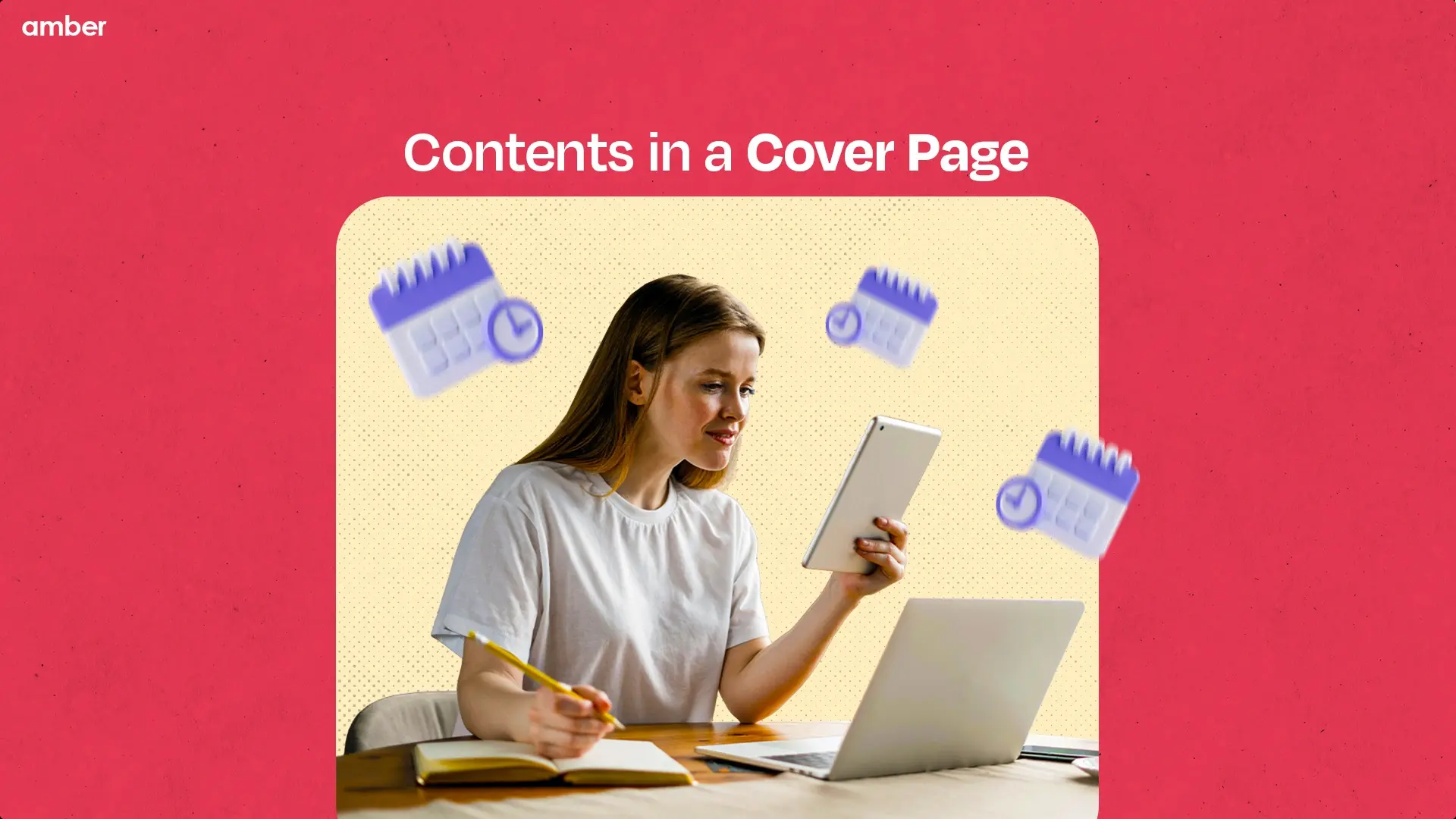
Level Up Your Assignment Game!
What if you made a shiny assignment but forgot to make the cover page? Remember that first impression in 'The Devil Wears Prada'? Well, your cover page for an assignment deserves a standing ovation, not a silent groan from your teacher. But don't worry! Here's an ultimate guide on how to make a cover page for an assignment that will transform your cover page from 'blah' to 'wow' in no time!

What is a Cover Page in an Assignment?
The cover page, your essay's first impression, sets the stage for professionalism. It's where your name, course details, and due date greet your instructor. Though not always obligatory, a polished presentation of the first page of an assignment can earn you favour. Following a good format for an assignment cover page for a university leads to higher scores, making it a smart academic move.
Why is a Cover Page Important?
As students, we all know the adage - you never get a second chance to make a first impression. That's where the cover page comes in - it's the gatekeeper to your assignment , and trust us, you don't want to drop the ball here. Mess it up, and your professor might write you off before they even start reading. But nail it? Well, that's like hitting a home run before you've even stepped up to the plate.
If you are thinking about how to make a cover page for an assignment, a well-formatted, error-free cover page is the key to unlocking your instructor's curiosity. Following the institution's template is just the cherry on top, showing you're a team player who respects the rules of the game.
How to Make a Cover Page for an Assignment?
When it comes to the question of how to make an assignment front page, the goal is clear! The cover page is our chance to grab the professor's attention right off the bat. Why settle for a drab intro when you can learn all about how to design the front page of an assignment? Let's dive into the essential elements of the cover page.
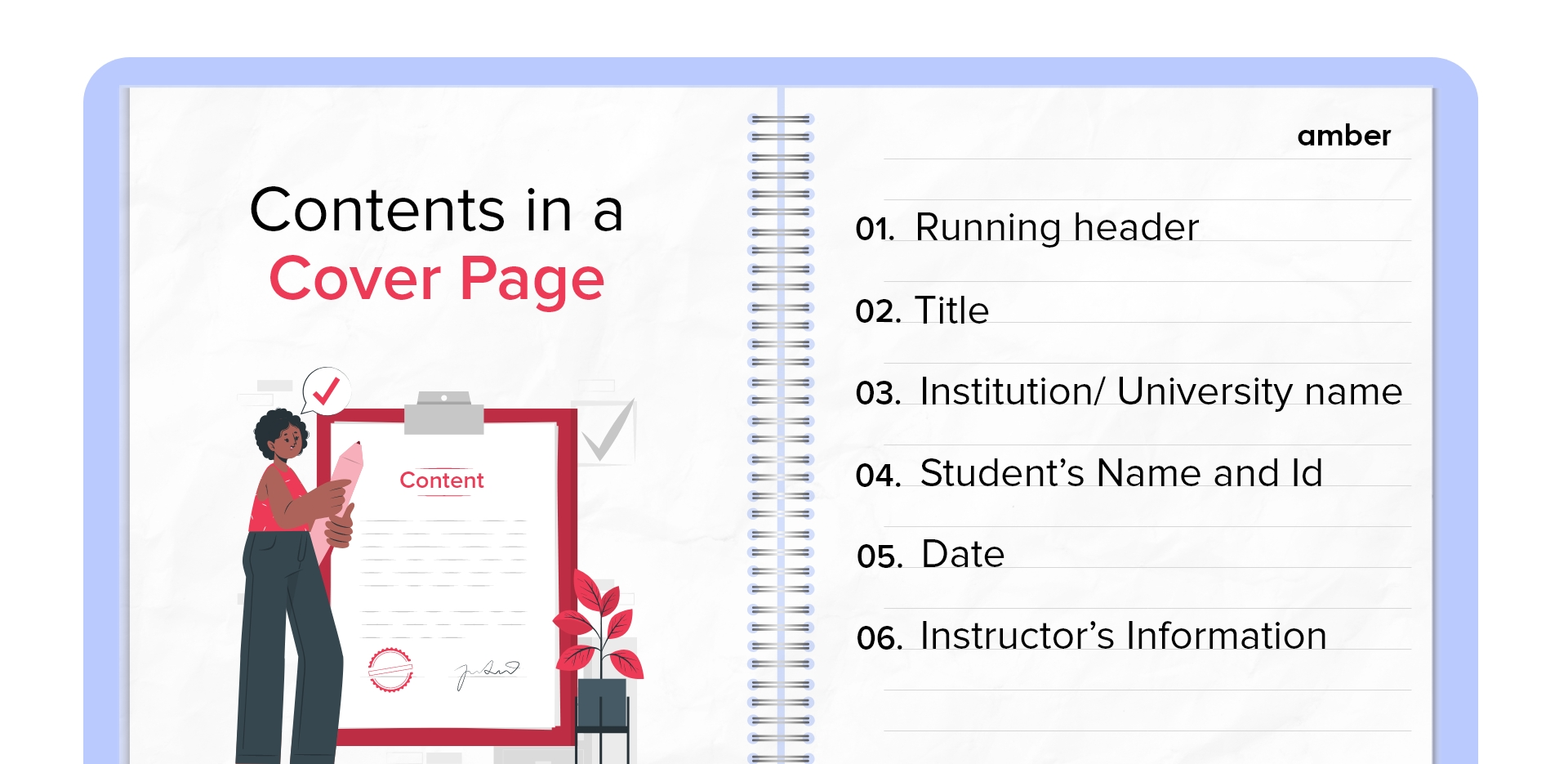
1. Running Header
A running header goes on top of the first page of an assignment, separate from the main text. It's often used for APA style. Keep it short, 50 characters max, all uppercase.
Next is the title, explaining your work's content. Write it in the title case, capitalising most words. Avoid abbreviations and aim for 15-20 words. Centre the fully written title on the cover page.
3. Institution/ University Name
Your university or institution name belongs on the cover page for an assignment, too. Different from the title, it shows readers where you're from and did the research . For reports or presentations , include your workplace or college .
4. Student’s Name and ID
How to make a cover page for an assignment look credible? The answer is to Clearly state the author(s), name(s), and id(s) on the cover page. Include affiliations for multiple authors. For group projects, list all students' names and universities before the title. It ensures proper author credit.
Including the date on your cover page tells readers when you finished the work. Use the exact publication date. It also helps for future reference if someone needs to find work within a certain timeframe.
6. Instructor’s Information
Providing your instructor's details, such as name, designation, and department, shows you completed the work for their specific class. It ensures the assignment reaches the right person and department, avoiding any confusion.
7. Numbering the Pages Ensure that all pages of your assignment are numbered. It is typically done in the header or footer of each page, starting from the front page of an assignment as page 1 . Consistent page numbering helps maintain organisation and easy navigation of the document.
8. Bibliography A bibliography is a crucial part of any academic assignment, listing all the sources you referenced. It should be placed at the end of your assignment and formatted according to the required citation style (APA, MLA, Chicago, etc.). On the cover page, you can include a note indicating that a bibliography is included.
Make your assignment's cover page in peace with amber's comfortable housing!
Book through amber today!
How to Make A Front Page of an Assignment: APA Format
The APA (American Psychological Association) format heavily emphasises the cover page details. To know how to make a cover page for an assignment in an APA format, follow these specific guidelines.

1. Page Number Placement: Start by placing the page number in the upper-right corner, always as 1, aligning it with the one-inch margin. It will be part of your running head, a feature in APA format, but for student papers, it's just the page number.
2. Title Placement: Move down three or four lines (double-spaced) from the top and centre of the title page of an assignment. Make it bold and use proper capitalisation rules for titles.
3. Author's Name: After the title, leave an empty line, then write your name. Keep it simple without any special formatting. If there are multiple authors, separate their names with commas and use "and" before the last author's name.
4. Department and School: Below your name, write your department or division, followed by your school's name, separated by a comma.
5. Course Information: Include the course name and its numeric code directly below your school's name.
6. Instructor's Name: Under the course information, write your instructor's full name, including any titles like ' Dr. '
7. Date: Finally, on the last line, write the date. Spell out the month for clarity.
How to Create a Cover Page for an Assignment: MLA Format
In MLA (Modern Language Association) style, you usually don't need a cover page for an assignment; instead, you list essential details at the start of the first page. If you are wondering how to make an assignment front page in MLA style, here are the instructions.

1. Student’s Name: Begin with the first student’s name on the top-left corner of the page, double-spaced.
2. Additional Authors: If there are more authors, list each on a separate line following the first student’s name.
3. Instructor’s Name: Below, the last author’s name, including the instructor’s title, like “Professor Willow,” on a new line.
4. Course Details: Write the course name along with its numeric code on the next line.
5. Date: Following the course details, write the date in full, avoiding abbreviations for months. You can use either day-month-year or month-day-year format.
6. Title of the Paper: The most crucial part of the tip on how to make the title page of an assignment. Centre the title four or five lines below the date, maintaining double spacing. Remember to capitalise the title according to standard rules, avoiding bold or italics.
How to Design Cover Page for Assignment: CMS Format
CMS (Chicago Manual of Style), a citation method for acknowledging sources in academic papers, grants ownership rights to authors, preventing plagiarism and aiding readers in locating sources. However, mastering one style isn't sufficient due to varying rules.
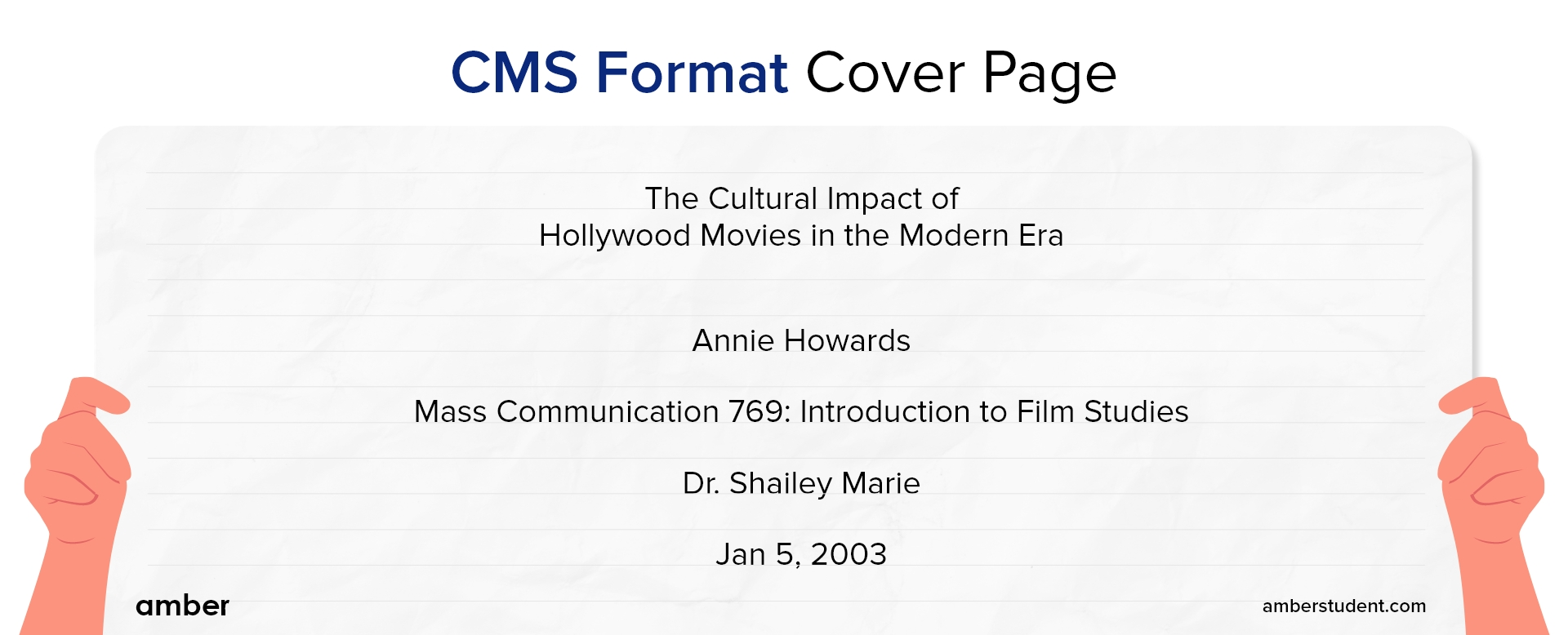
1. Margins: Leave one-inch margins on all sides of your cover page to give it a neat look and provide space for your text.
2. Font: Stick to Times or Times New Roman font in 12 pt size for a professional appearance that's easy to read.
3. Spacing: Double-space the text on your cover page to make it clear and readable.
4. Text Alignment: Align your text to the left to create a clean, organised appearance, avoiding fully justified text.
5. Indentation: For a structured layout, start paragraphs, block quotes, and bibliography entries with a 1/2" indent.
6. Page Numbers: Number your pages in the top right corner, excluding the cover page. Include your last name to avoid confusion if pages get mixed up.
7. Two-Sided Printing: Confirm with your teacher if you can print on both sides of the paper for eco-friendly printing.
8. Title: Centre the title of your paper halfway down the page for prominence and clarity.
9. Name: Centre your name under the title to identify yourself as the author.
10. Teacher's Information: Write your teacher's name, the course title, and the date at the bottom, centred in three lines.
11. Font Consistency: Maintain consistency by using Times or Times New Roman font in 12 pt size for the cover page. Avoid using bold, underline, or decorative fonts.
12. Page Numbering and Count: Exclude the cover page from page numbering and total page count. It's not necessary to add a page number to the cover page.
Tips and Tricks to How to Make a Good Cover Page for an Assignment?
Now that you have understood how to make a cover page for an assignment, it is also necessary to understand the basic tips and tricks before you start writing one. To make a great cover page, follow the steps outlined in the guide.
1. Correct Information
The main answer to the question of how to design a cover page for an assignment is to ensure that it includes accurate details such as your name, assignment title, course name, date, and any other required information to avoid confusion and errors.
2. Formatting
Use consistent formatting throughout the cover page, including font style, size, and spacing, to present a polished and organised appearance that aligns with academic standards.
3. Relevance
If you’re wondering how to write the front page of an assignment, then include relevant details that provide context. It would help the reader understand the purpose and scope of your work.
4. Clarity and Conciseness
Keep the content of the cover page clear and concise, using simple language and avoiding unnecessary information to communicate your message effectively.
5. Professional Tone
Maintain a professional tone on the cover page by using formal language and addressing the recipient respectfully, reflecting your commitment to the assignment and your academic integrity.
6. Proofreading
Carefully proofread the cover page for any grammatical errors, typos, or inconsistencies. Ensure it reflects your attention to detail and presents a polished final product.
A well-crafted cover page can make your assignment shine like a diamond in the rough. Follow these tips for how to write the front page of an assignment, and you'll impress your professor right off the bat. Don't drop the ball on this crucial first impression; knock their socks off with an A+ cover page material! The best part is that a good cover can improve your grades drastically!
Frequently Asked Questions
What are the essential elements of a cover page, what tools or software can i use to design a cover page, what are common mistakes to avoid when creating a cover page, what's the difference between a cover page in apa format vs. mla format, how to make a cover page for an assignment on canva.
Your ideal student home & a flight ticket awaits
Follow us on :

Related Posts
.jpg)
10 Best Online Tutoring Websites

10 Best Healthcare Courses in Australia in 2024
.jpg)
AS And A Levels: Which Path Should You Take?

amber © 2024. All rights reserved.
4.8/5 on Trustpilot
Rated as "Excellent" • 4800+ Reviews by students
Rated as "Excellent" • 4800+ Reviews by Students

Free Cover Page templates
Create impressive cover pages for your assignments and projects online in just a click. choose from hundreds of free templates and customize them with edit.org..
Create impressive cover pages in a few minutes with Edit.org, and give your projects and assignments a professional and unique touch. A well-designed title page or project front page can positively impact your professor's opinion of your homework, which can improve your final grade!

Create a personalized report cover page
After writing the whole report, dissertation, or paper, which is the hardest part, you should now create a cover page that suits the rest of the project. Part of the grade for your work depends on the first impression of the teacher who corrects it.
We know not everyone is a professional designer, and that's why Edit.org wants to help you. Having a professional title page can give the impression you've put a great deal of time and effort into your assignment, as well as the impression you take the subject very seriously. Thanks to Edit.org, everyone can become a professional designer. This way, you'll only have to worry about doing a great job on your assignment.
On the editor, you will also find free resume templates and other educational and professional designs.

Customize an essay cover page with Edit.org
- Go to formats on the home page and choose Cover pages.
- Choose the template that best suits the project.
- You can add your images or change the template background color.
- Add your report information and change the font type and colors if needed.
- Save and download it. The cover page is ready to make your work shine!

Free editable templates for title pages
As you can see, it's simple to create cover pages for schoolwork and it won’t take much time. We recommend using the same colors on the cover as the ones you used for your essay titles to create a cohesive design. It’s also crucial to add the name and logo of the institution for which you are doing the essay. A visually attractive project is likely to be graded very well, so taking care of the small details will make your work look professional.
On Edit.org, you can also reuse all your designs and adapt them to different projects. Thanks to the users' internal memory, you can access and edit old templates anytime and anywhere.

Take a look at other options we propose on the site. Edit.org helps design flyers, business cards, and other designs useful in the workplace. The platform was created so you don't need to have previous design knowledge to achieve a spectacular cover page! Start your cover page design now.
Create online Cover Pages for printing
You can enter our free graphic editor from your phone, tablet or computer. The process is 100% online, fun and intuitive. Just click on what you want to modify. Customize your cover page quickly and easily. You don't need any design skills. No Photoshop skills. Just choose a template from this article or from the final waterfall and customize it to your liking. Writing first and last names, numbers, additional information or texts will be as easy as writing in a Word document.
Free templates for assignment cover page design
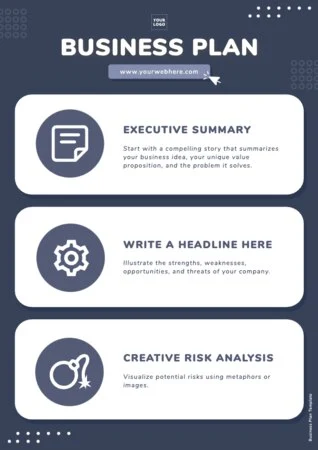
Tumblr Banners

Facebook Event Covers

Album Covers
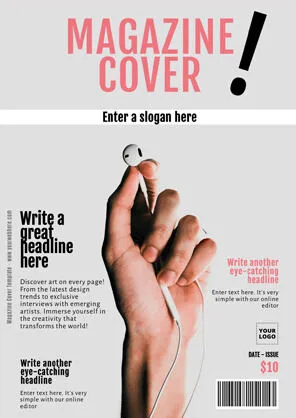
Magazine Covers
5 Steps Guide On How To Write Assignment First Page
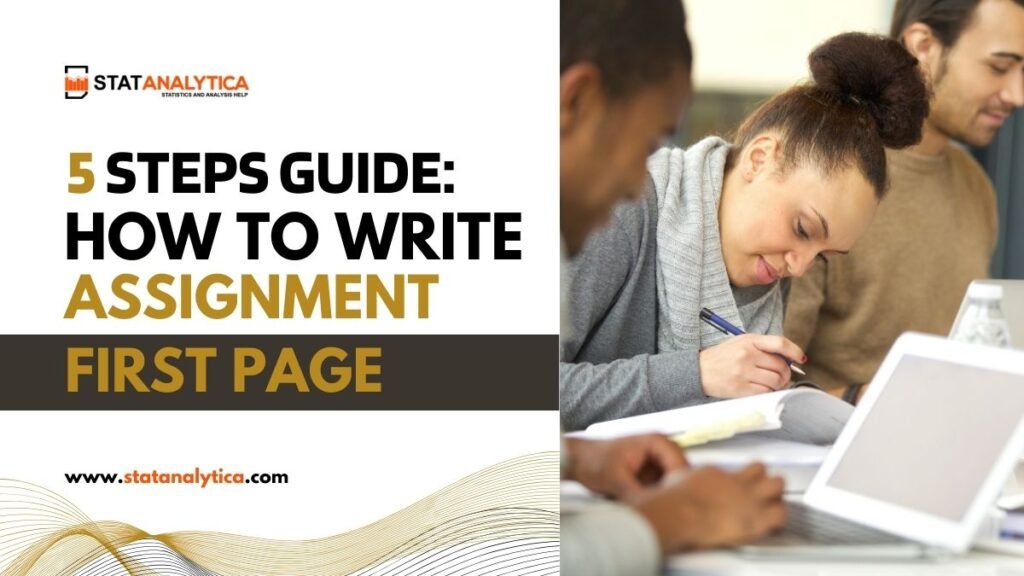
The assignment’s first page acts like a welcoming handshake—it’s the initial impression that sets the stage for your work. It grabs attention, providing essential details about what follows. A well-crafted first page isn’t just about rules; it’s your chance to engage your reader and show your commitment to delivering quality work.
It isn’t just about looks—it’s the mood setter. It cues readers about what to expect, conveying the vibe and seriousness of your work. It’s like the opening scene of a movie, shaping expectations and guiding your audience through the journey ahead.
So today we are going to see the answer to a very common question i.e. how to write assignment first page. It will serve as a complete guide book for you.
Importance Of A Good Assignment
Table of Contents
Assignment’s are the basis of your grades and not only grades it represents your character and thinking. It plays an important role in a student’s life and following are some points which will make it more to you.
- Academic Success: A well-crafted assignment demonstrates understanding and mastery of the subject matter, contributing to academic achievements.
- Demonstration of Knowledge: It showcases your grasp of concepts, theories, and application of learned materials.
- Preparation for Real-world Skills: It cultivates skills like time management, organisation, and research, which are valuable in professional settings.
- Feedback and Improvement: Feedback received on assignments helps identify areas for improvement, aiding in continuous learning and growth.
- Building a Portfolio: High-quality assignments can serve as a portfolio demonstrating expertise and skills for future opportunities.
After this the importance of a well-executed assignment cannot be overstated. In recognizing the crucial role of a well-executed assignment, we understand the challenges students face in meeting these academic standards.
That’s why our assignment help service is here as a guiding hand, supporting students in crafting exceptional assignments that not only meet requirements but also exceed expectations.
5 Steps: How To Write Assignment First Page
For helping you in order to make an effective first page for assignment and creating a good impression we have summarised all the essentials in 5 steps and they are as:
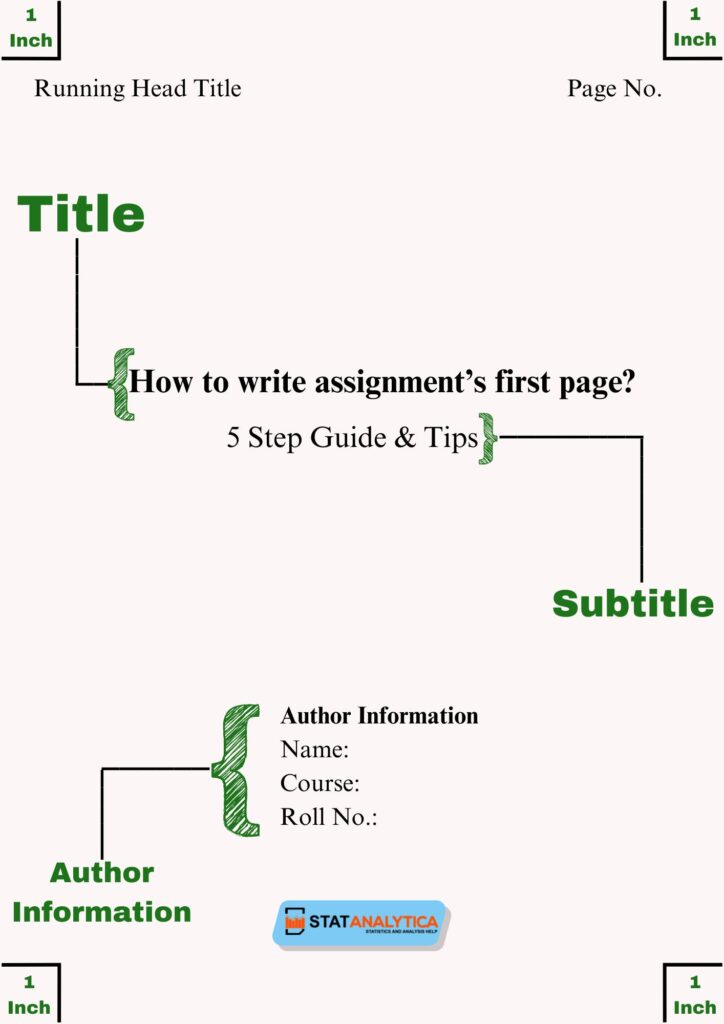
Step 1: Grasping Specific Formatting Requirements For Assignment First Page
It is always required to understand the specific formatting requirements, such as font size, spacing, and placement of details, to create a professional and polished cover page. Different universities and departments may have varying formatting guidelines, so it’s crucial to check the assignment description and rubric for specific instructions.
Step 2: Guidelines On Font Spacing And Margins
Follow these standards ensures a clean and professional appearance for your assignment’s first page:
Font Style and Size:
- Use a readable font style like Times New Roman, Arial, or Calibri.
- Typical font size is 12 points for the main text.
- For headings and subheadings, consider slightly larger sizes (14-16 points) for differentiation.
- Double-space the entire text, including the title, subtitles, and body paragraphs.
- Ensure consistency in spacing—don’t mix double-spacing with single-spacing within the document.
- Set margins on one-inch margins on each side of the page (top, bottom, left, and right).
- Check if your instructor or institution specifies different margin requirements.
Step 3: Structuring The First Page
Structuring the First Page is crucial in laying the groundwork for a well-presented assignment. Proper placement of elements like Title and Subtitle sets the tone, guiding readers into your work. Author Information and Affiliation lend credibility, while Date and Course Details establish context, forming the backbone of your assignment’s initial impression. Mastering these placements ensures a professional and organised first page. Here are some key points to consider:
- Title and Subtitle Placement: The Title and Subtitle are the front door of your assignment; they should be clear and inviting. Place the main title at the center, standing out boldly, while the subtitle, if used, can follow underneath to offer a sneak peek into your assignment’s focus. Keep them concise yet informative, giving readers a glimpse of what’s to come.
- Author Information and Affiliation: Author Information and Affiliation is like introducing yourself before a conversation. It goes at the bottom of the title page, including your name and any relevant details like your university or course. It adds credibility to your work, helping readers understand your perspective and expertise in the subject.
- Date and Course Details : The Date and Course Details are the assignment’s GPS they show where and when it belongs. Placed below the author’s info, they provide context, indicating when the assignment was crafted and for which course. It helps organise your work and ensures clarity for anyone reading it, making sure they know its relevance and timeline.
Step 4:Crafting A Compelling Title For Assignment First Page
Crafting an appealing Title requires a perfect mix of creativity and clarity, essential for catching readers’ attention while staying true to the assignment’s essence. Here are some tips to achieve this balance:
- Be Specific yet Engaging: Craft a title that hints at the assignment’s focus without giving away everything, sparking curiosity.
- Use Powerful Language: Incorporate strong, descriptive words that evoke interest and relevance to the assignment’s content.
- Consider the Tone: Match the title’s tone to the assignment’s nature, whether it’s formal, informative, or creative.
- Avoid Ambiguity: Ensure the title accurately represents the assignment’s core concepts while avoiding vagueness or confusion.
- Get Feedback: Test the title’s impact by seeking opinions from peers or colleagues to gauge its effectiveness in grabbing attention while maintaining clarity.
Step 5: Subtitle Or Abstract
The Subtitle or Abstract serves as a supporting actor, providing additional context to the main title and offering a concise summary of your assignment. Its inclusion is vital for:
- Enhanced Clarity: The subtitle elucidates the main title, providing a brief overview of the assignment’s scope or focus.
- Informative Preview: It offers readers a glimpse into the assignment’s content, helping them understand what to expect.
- Summary of Main Points: Briefly outline the central themes or objectives of the assignment.
- Relevance: Explain the assignment’s significance or relevance to the subject matter.
- Scope: Highlight the boundaries or limitations of the assignment’s coverage.
- Engagement: Aim for a captivating summary that entices readers to delve deeper into the assignment.
Dos And Don’ts For The First Page
A professional and powerful beginning to your work is ensured by following the Dos and Don’ts for the First Page. Here are some of them:
- Follow Guidelines: Adhere strictly to formatting and style guidelines provided by your institution or instructor.
- Ensure Accuracy: Double-check all details such as names, dates, and course information for accuracy.
- Maintain Professionalism: Use a formal tone, proper language, and avoid casual or colloquial expressions .
Don’ts:
- Avoid Overcrowding : Refrain from cluttering the page with excessive information or decorative elements.
- Skipping Proofreading: Never submit without proofreading; errors can diminish the assignment’s credibility.
- Steer Clear of Plagiarism: Always cite sources properly to avoid plagiarism issues.
Best Practices:
- Consistency is Key: Ensure uniformity in font, spacing, and margins throughout the first page.
- Prioritise Clarity: Keep content concise, clear, and relevant, avoiding unnecessary information.
- Seek Feedback: Consider seeking feedback from peers or mentors to refine the first page for maximum impact.
In crafting an assignment first page, following these five essential steps of formatting, title creation, abstract drafting, structuring, and adhering to dos and don’ts can make a significant difference. By understanding the importance of formatting guidelines (for How To Write Assignment First Page), creating an engaging title and informative abstract, structuring the page effectively, and avoiding common pitfalls, anyone can set the stage for a compelling and professional assignment. Remember, the first page acts as a gateway, making a lasting impression on your readers. Paying attention to these steps ensures clarity, professionalism, and an inviting introduction to your work, ultimately ensuring the way to a successful academic journey.
Related Posts

7+ Tips On How To Get Higher Grades In Exams In 2023

How to Write a Research Paper- A guide From Professionals
Log In / Sign Up
Log in / sign up mysupergeek account.
- Plan and manage tasks
- Add and store materials
- Chat with Geeks to get help
How to Write the Perfect Assignment First Page
You've been assigned a paper, and after several cups of coffee and late nights, you’ve finally finished the meaty content. But have you paid attention to the first page? Believe it or not, the first page of your assignment is more than just a formality. It sets the tone for your work and can make or break that all-important first impression. In this article, we’ll guide you through crafting an assignment first page that is both professional and engaging.
Components of a Well-Crafted First Page
Significance: Your title isn't just a label; it's the billboard of your assignment. A strong title pulls readers in while providing an accurate description of your work.
Tips: Make it engaging yet concise. If possible, use relevant keywords without making it sound robotic.
Your Name and Contact Information
Placement: Your name usually goes at the top, either centered or aligned to the left or right.
Details to Include: Your full name, email address, and sometimes your student ID should suffice. Ensure that this information is easy to locate and read.
Importance: Dates are crucial for archival and accountability reasons.
Format: Stick to the format specified by your instructor or institution, but commonly used formats include Month Day, Year (e.g., September 18, 2023).
Instructor's Name and Class Details
Significance: This helps to ensure your assignment reaches the correct person and class.
How to Include: Typically aligned to the left, include the instructor’s full name, the course name, and the course code.
Assignment Instructions or Objectives
Role: Clarifying what the assignment aims to achieve or the questions it aims to answer can be beneficial for both you and the reader.
Presentation: A brief paragraph or bullet points work well. Keep it short but informative.
Design Elements to Consider
Importance: Proper margins provide a neat and organized look.
Standard Margins: Typically, one-inch margins on all sides work well.
Font and Size
Optimal Choices: Times New Roman or Arial are safe bets. Size 12 is usually the norm.
Do’s and Don’ts: Avoid fonts that are hard to read or overly decorative, like Comic Sans or Papyrus.
Spacing and Alignment
Significance: Consistent spacing and alignment give your assignment a polished appearance.
Tips: Double-spacing is often required. Make sure to align your text according to the assignment's requirements.
Additional Features
Page numbers.
Importance: Even on the first page, page numbers help to keep your assignment organized.
Placement: Usually, the bottom-right corner is the go-to spot.
Headers and Footers
Advantages: These can include additional information like your last name or the course code, which helps if pages become separated.
What to Include: Keep it simple: Your last name and maybe the assignment's due date or course code.
Graphics and Visual Elements
Pros and Cons: Visual elements can enhance understanding but can also be distracting.
Guidelines: Stick to the essentials like tables or figures that directly relate to your assignment content.
Common Mistakes to Avoid
- Overcrowding - Too much information can make the first page look cluttered. Use the rest of the assignment to showcase your knowledge and leave the first page clean and straightforward.
- Inconsistency - Use the same font, size, and spacing throughout your assignment. Consistency is key to a professional look.
- Ignoring Guidelines - Always read and follow any guidelines or templates provided by your instructor or institution. Your creativity should be within those bounds.
The first page of your assignment is not just a bureaucratic requirement; it's an opportunity. An opportunity to set the tone, showcase professionalism, and create a lasting impression. So the next time you're pulling that all-nighter for an assignment, remember that the first page deserves its share of your time and creativity.

A step-by-step guide for creating and formatting APA Style student papers
The start of the semester is the perfect time to learn how to create and format APA Style student papers. This article walks through the formatting steps needed to create an APA Style student paper, starting with a basic setup that applies to the entire paper (margins, font, line spacing, paragraph alignment and indentation, and page headers). It then covers formatting for the major sections of a student paper: the title page, the text, tables and figures, and the reference list. Finally, it concludes by describing how to organize student papers and ways to improve their quality and presentation.
The guidelines for student paper setup are described and shown using annotated diagrams in the Student Paper Setup Guide (PDF, 3.40MB) and the A Step-by-Step Guide to APA Style Student Papers webinar . Chapter 1 of the Concise Guide to APA Style and Chapter 2 of the Publication Manual of the American Psychological Association describe the elements, format, and organization for student papers. Tables and figures are covered in Chapter 7 of both books. Information on paper format and tables and figures and a full sample student paper are also available on the APA Style website.
Basic setup
The guidelines for basic setup apply to the entire paper. Perform these steps when you first open your document, and then you do not have to worry about them again while writing your paper. Because these are general aspects of paper formatting, they apply to all APA Style papers, student or professional. Students should always check with their assigning instructor or institution for specific guidelines for their papers, which may be different than or in addition to APA Style guidelines.
Seventh edition APA Style was designed with modern word-processing programs in mind. Most default settings in programs such as Academic Writer, Microsoft Word, and Google Docs already comply with APA Style. This means that, for most paper elements, you do not have to make any changes to the default settings of your word-processing program. However, you may need to make a few adjustments before you begin writing.
Use 1-in. margins on all sides of the page (top, bottom, left, and right). This is usually how papers are automatically set.
Use a legible font. The default font of your word-processing program is acceptable. Many sans serif and serif fonts can be used in APA Style, including 11-point Calibri, 11-point Arial, 12-point Times New Roman, and 11-point Georgia. You can also use other fonts described on the font page of the website.
Line spacing
Double-space the entire paper including the title page, block quotations, and the reference list. This is something you usually must set using the paragraph function of your word-processing program. But once you do, you will not have to change the spacing for the entirety of your paper–just double-space everything. Do not add blank lines before or after headings. Do not add extra spacing between paragraphs. For paper sections with different line spacing, see the line spacing page.
Paragraph alignment and indentation
Align all paragraphs of text in the body of your paper to the left margin. Leave the right margin ragged. Do not use full justification. Indent the first line of every paragraph of text 0.5-in. using the tab key or the paragraph-formatting function of your word-processing program. For paper sections with different alignment and indentation, see the paragraph alignment and indentation page.
Page numbers
Put a page number in the top right of every page header , including the title page, starting with page number 1. Use the automatic page-numbering function of your word-processing program to insert the page number in the top right corner; do not type the page numbers manually. The page number is the same font and font size as the text of your paper. Student papers do not require a running head on any page, unless specifically requested by the instructor.
Title page setup
Title page elements.
APA Style has two title page formats: student and professional (for details, see title page setup ). Unless instructed otherwise, students should use the student title page format and include the following elements, in the order listed, on the title page:
- Paper title.
- Name of each author (also known as the byline).
- Affiliation for each author.
- Course number and name.
- Instructor name.
- Assignment due date.
- Page number 1 in the top right corner of the page header.
The format for the byline depends on whether the paper has one author, two authors, or three or more authors.
- When the paper has one author, write the name on its own line (e.g., Jasmine C. Hernandez).
- When the paper has two authors, write the names on the same line and separate them with the word “and” (e.g., Upton J. Wang and Natalia Dominguez).
- When the paper has three or more authors, separate the names with commas and include “and” before the final author’s name (e.g., Malia Mohamed, Jaylen T. Brown, and Nia L. Ball).
Students have an academic affiliation, which identities where they studied when the paper was written. Because students working together on a paper are usually in the same class, they will have one shared affiliation. The affiliation consists of the name of the department and the name of the college or university, separated by a comma (e.g., Department of Psychology, George Mason University). The department is that of the course to which the paper is being submitted, which may be different than the department of the student’s major. Do not include the location unless it is part of the institution’s name.
Write the course number and name and the instructor name as shown on institutional materials (e.g., the syllabus). The course number and name are often separated by a colon (e.g., PST-4510: History and Systems Psychology). Write the assignment due date in the month, date, and year format used in your country (e.g., Sept. 10, 2020).
Title page line spacing
Double-space the whole title page. Place the paper title three or four lines down from the top of the page. Add an extra double-spaced blank like between the paper title and the byline. Then, list the other title page elements on separate lines, without extra lines in between.
Title page alignment
Center all title page elements (except the right-aligned page number in the header).
Title page font
Write the title page using the same font and font size as the rest of your paper. Bold the paper title. Use standard font (i.e., no bold, no italics) for all other title page elements.
Text elements
Repeat the paper title at the top of the first page of text. Begin the paper with an introduction to provide background on the topic, cite related studies, and contextualize the paper. Use descriptive headings to identify other sections as needed (e.g., Method, Results, Discussion for quantitative research papers). Sections and headings vary depending on the paper type and its complexity. Text can include tables and figures, block quotations, headings, and footnotes.
Text line spacing
Double-space all text, including headings and section labels, paragraphs of text, and block quotations.
Text alignment
Center the paper title on the first line of the text. Indent the first line of all paragraphs 0.5-in.
Left-align the text. Leave the right margin ragged.
Block quotation alignment
Indent the whole block quotation 0.5-in. from the left margin. Double-space the block quotation, the same as other body text. Find more information on the quotations page.
Use the same font throughout the entire paper. Write body text in standard (nonbold, nonitalic) font. Bold only headings and section labels. Use italics sparingly, for instance, to highlight a key term on first use (for more information, see the italics page).
Headings format
For detailed guidance on formatting headings, including headings in the introduction of a paper, see the headings page and the headings in sample papers .
- Alignment: Center Level 1 headings. Left-align Level 2 and Level 3 headings. Indent Level 4 and Level 5 headings like a regular paragraph.
- Font: Boldface all headings. Also italicize Level 3 and Level 5 headings. Create heading styles using your word-processing program (built into AcademicWriter, available for Word via the sample papers on the APA Style website).
Tables and figures setup
Tables and figures are only included in student papers if needed for the assignment. Tables and figures share the same elements and layout. See the website for sample tables and sample figures .
Table elements
Tables include the following four elements:
- Body (rows and columns)
- Note (optional if needed to explain elements in the table)
Figure elements
Figures include the following four elements:
- Image (chart, graph, etc.)
- Note (optional if needed to explain elements in the figure)
Table line spacing
Double-space the table number and title. Single-, 1.5-, or double-space the table body (adjust as needed for readability). Double-space the table note.
Figure line spacing
Double-space the figure number and title. The default settings for spacing in figure images is usually acceptable (but adjust the spacing as needed for readability). Double-space the figure note.
Table alignment
Left-align the table number and title. Center column headings. Left-align the table itself and left-align the leftmost (stub) column. Center data in the table body if it is short or left-align the data if it is long. Left-align the table note.
Figure alignment
Left-align the figure number and title. Left-align the whole figure image. The default alignment of the program in which you created your figure is usually acceptable for axis titles and data labels. Left-align the figure note.
Bold the table number. Italicize the table title. Use the same font and font size in the table body as the text of your paper. Italicize the word “Note” at the start of the table note. Write the note in the same font and font size as the text of your paper.
Figure font
Bold the figure number. Italicize the figure title. Use a sans serif font (e.g., Calibri, Arial) in the figure image in a size between 8 to 14 points. Italicize the word “Note” at the start of the figure note. Write the note in the same font and font size as the text of your paper.
Placement of tables and figures
There are two options for the placement of tables and figures in an APA Style paper. The first option is to place all tables and figures on separate pages after the reference list. The second option is to embed each table and figure within the text after its first callout. This guide describes options for the placement of tables and figures embedded in the text. If your instructor requires tables and figures to be placed at the end of the paper, see the table and figure guidelines and the sample professional paper .
Call out (mention) the table or figure in the text before embedding it (e.g., write “see Figure 1” or “Table 1 presents”). You can place the table or figure after the callout either at the bottom of the page, at the top of the next page, or by itself on the next page. Avoid placing tables and figures in the middle of the page.
Embedding at the bottom of the page
Include a callout to the table or figure in the text before that table or figure. Add a blank double-spaced line between the text and the table or figure at the bottom of the page.
Embedding at the top of the page
Include a callout to the table in the text on the previous page before that table or figure. The table or figure then appears at the top of the next page. Add a blank double-spaced line between the end of the table or figure and the text that follows.
Embedding on its own page
Embed long tables or large figures on their own page if needed. The text continues on the next page.
Reference list setup
Reference list elements.
The reference list consists of the “References” section label and the alphabetical list of references. View reference examples on the APA Style website. Consult Chapter 10 in both the Concise Guide and Publication Manual for even more examples.
Reference list line spacing
Start the reference list at the top of a new page after the text. Double-space the entire reference list (both within and between entries).
Reference list alignment
Center the “References” label. Apply a hanging indent of 0.5-in. to all reference list entries. Create the hanging indent using your word-processing program; do not manually hit the enter and tab keys.
Reference list font
Bold the “References” label at the top of the first page of references. Use italics within reference list entries on either the title (e.g., webpages, books, reports) or on the source (e.g., journal articles, edited book chapters).
Final checks
Check page order.
- Start each section on a new page.
- Arrange pages in the following order:
- Title page (page 1).
- Text (starts on page 2).
- Reference list (starts on a new page after the text).
Check headings
- Check that headings accurately reflect the content in each section.
- Start each main section with a Level 1 heading.
- Use Level 2 headings for subsections of the introduction.
- Use the same level of heading for sections of equal importance.
- Avoid having only one subsection within a section (have two or more, or none).
Check assignment instructions
- Remember that instructors’ guidelines supersede APA Style.
- Students should check their assignment guidelines or rubric for specific content to include in their papers and to make sure they are meeting assignment requirements.
Tips for better writing
- Ask for feedback on your paper from a classmate, writing center tutor, or instructor.
- Budget time to implement suggestions.
- Use spell-check and grammar-check to identify potential errors, and then manually check those flagged.
- Proofread the paper by reading it slowly and carefully aloud to yourself.
- Consult your university writing center if you need extra help.
About the author

Undergraduate student resources
Search our database of 10,000+ Microsoft Office templates.
28+ Best Free Assignment Cover Page Formats for MS Word
What is an assignment cover page, key elements for a comprehensive front page.
- Institution Details: Begin by prominently featuring the name of your school, college, or institute. This establishes credibility and provides context for your assignment.
- Personal Information: Include your own name to indicate authorship and ownership of the assignment. This adds a personal touch and facilitates easy identification.
- Assignment Title: Clearly state the title of your assignment, conveying its purpose and focus. A concise and informative title sets the tone for your work.
- Course Information: Specify the relevant course title or code to indicate the academic context in which your assignment was completed. This assists in proper categorization and organization.
- Instructor’s Name: Acknowledge the teacher or professor who will be evaluating your assignment by including their name. This demonstrates respect and professionalism.
- Due Date: Clearly indicate the deadline or due date for the assignment submission. This ensures timely assessment and helps you stay organized.
What are the basic tips?
- Font style : It is always in the best interest to use bold, simple, and clear text instead of using fancy text fonts and styles. This helps the reader understand things in a better way. Moreover, the usage of pictures behind texts must be avoided as it creates poor visibility for the reader when reading the text printed on it.
- Presentation: Presentation plays an important role in expressing what you need to convey to someone and how you need to communicate it. Presenting the title page in the most effective manner is essential as this leaves an impression on the teacher reading the assignment. It also acts as a decisive tool for the teacher whether or not he/ she interestingly goes through the whole document.
- Spell Check: Before handing over the assignment, one should take a brief review of all the spelling and also look for any grammatical errors.
- Avoid plagiarism: A student must always be honest in what he writes. He should avoid copying material or texts from anywhere.
- Personal detail: One should never forget to mention his/her name. The font size used for writing the name must be bigger so that it makes the name visible to the teacher.
Advantages of an Impressive Assignment Cover Page
- Showcasing Professionalism: By meticulously designing your cover page, you demonstrate a strong commitment to professionalism. This attention to detail reflects positively on your work ethic and sets you apart as a dedicated student.
- Creating a Positive Impression: A well-crafted front page sets the tone for your assignment, capturing the attention of your teacher or professor. It establishes a positive first impression, arousing their interest and encouraging them to delve further into your work.
- Enhancing Visual Appeal: A visually appealing cover page enhances the overall presentation of your assignment. With carefully chosen fonts, colors, and layouts, you create an engaging and aesthetically pleasing introduction that captivates the reader’s attention.
- Communicating Pertinent Information: It provides a concise summary of essential details, such as the assignment title, your name, and the due date. This ensures clarity and facilitates seamless identification and organization of your work.
- Reflecting a Professional Attitude: By dedicating time and effort to creating an impressive cover page, you exemplify a professional attitude towards your academic pursuits. This level of dedication and care leaves a lasting impression on your teacher or professor.
Download Free Cover Page Templates
#1 – best format.

#2 – Assignment Cover Page for Case Study
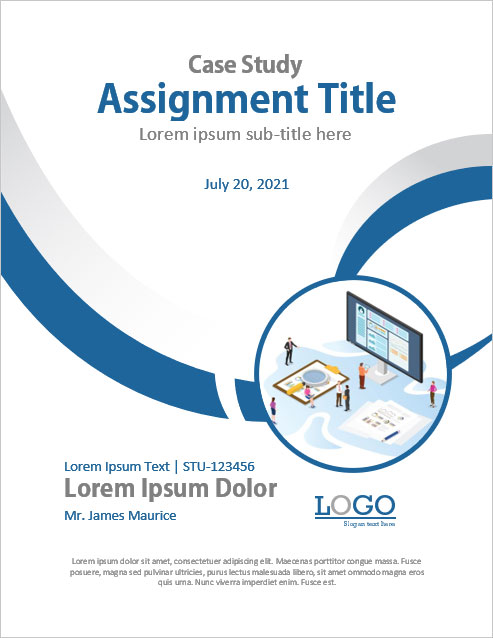
#3 – Best Design for Critical Review
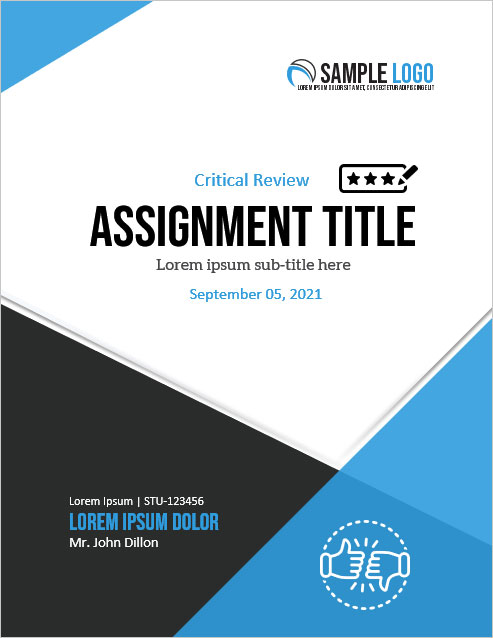
#4 – For Any Kind of Educational Assignment
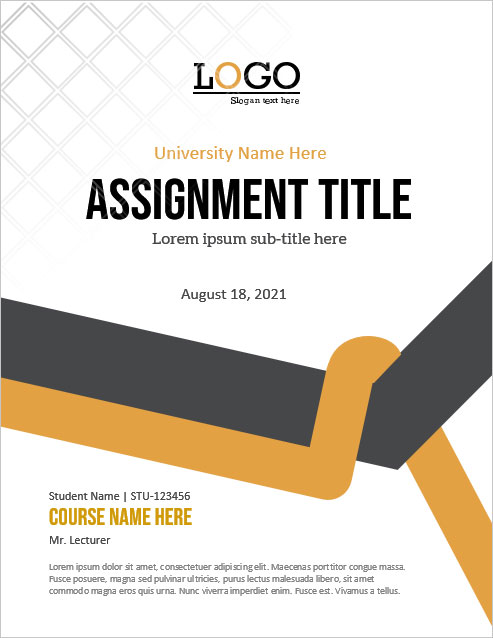
Video Tutorial
#5 – essay assignment.
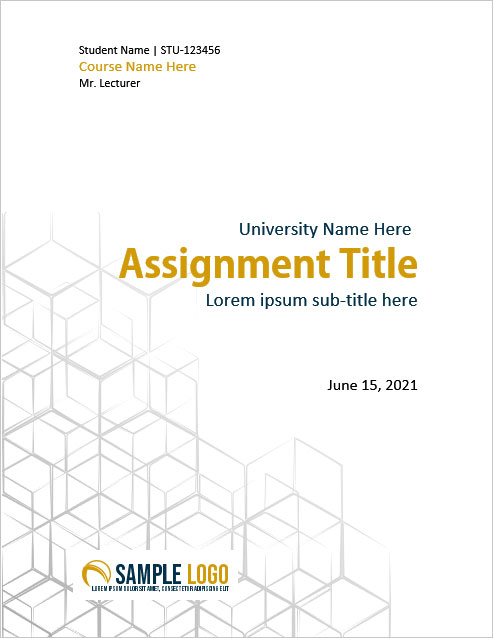
#6 – Syllabus Assignment
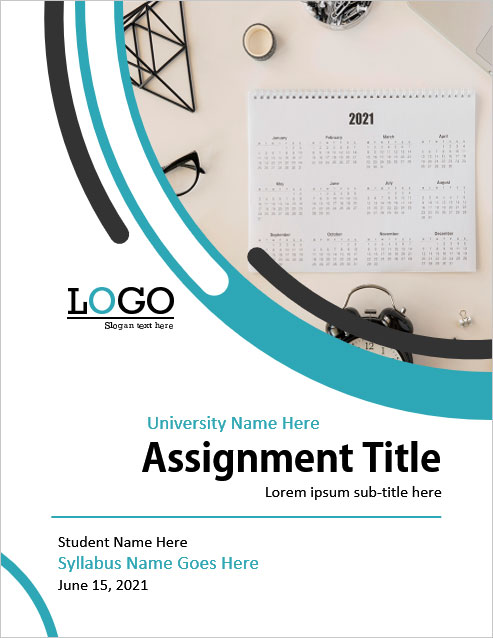
#7 – Cover Page For University Assignments
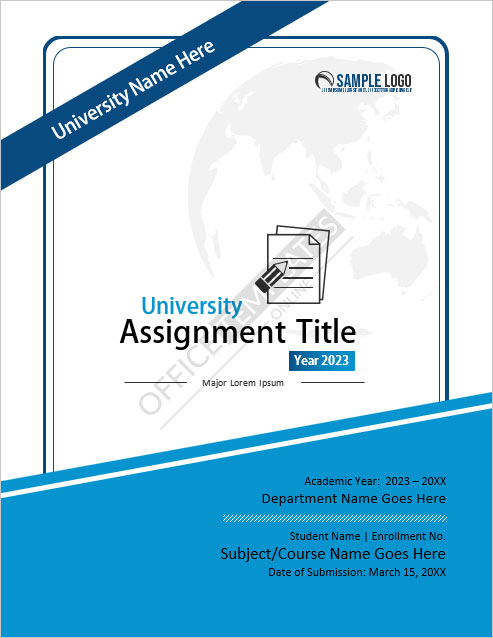
#14 – Cover Page for Business Assignment
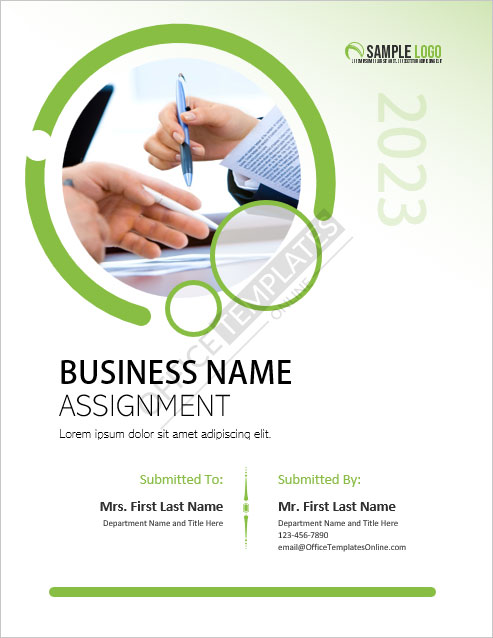
#16 – Academic
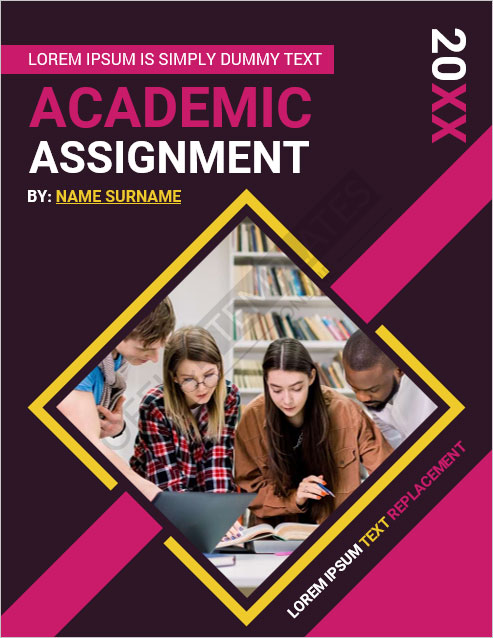
#17 – Generic Cover Page for any Assignment
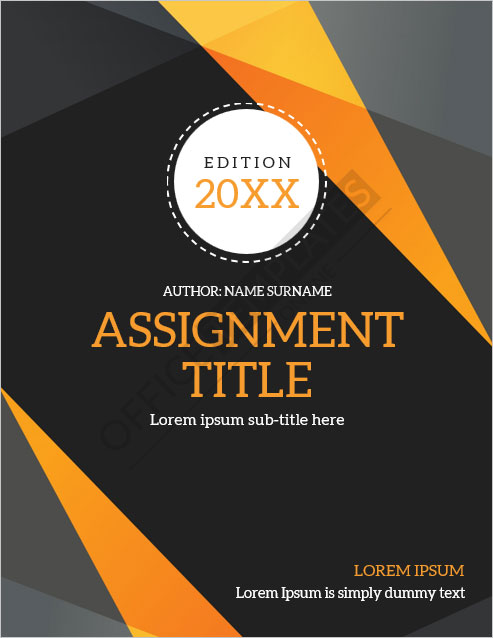
#18 – Biology Assignment
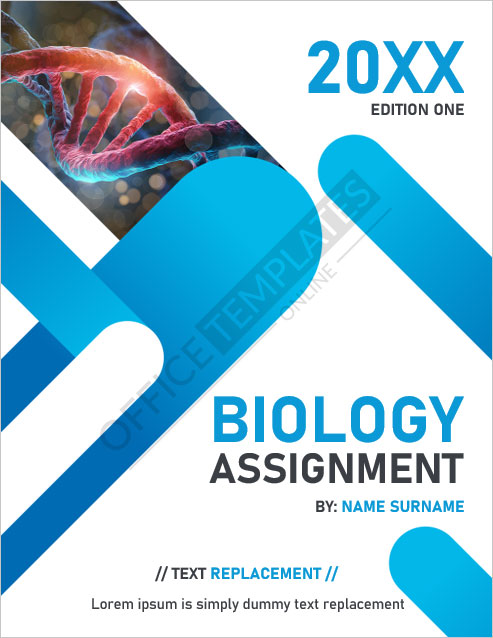
#19 – For Chemistry Projects

#20 – Cover Page for Computer Projects
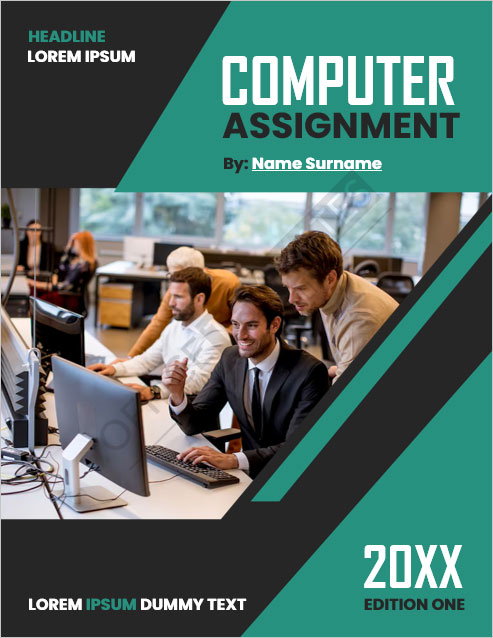

#21 – For Engineering-Related Assignments
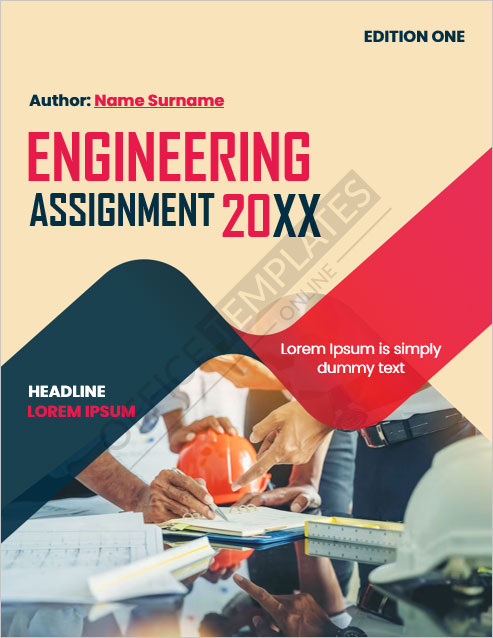
#22 – For English Assignment
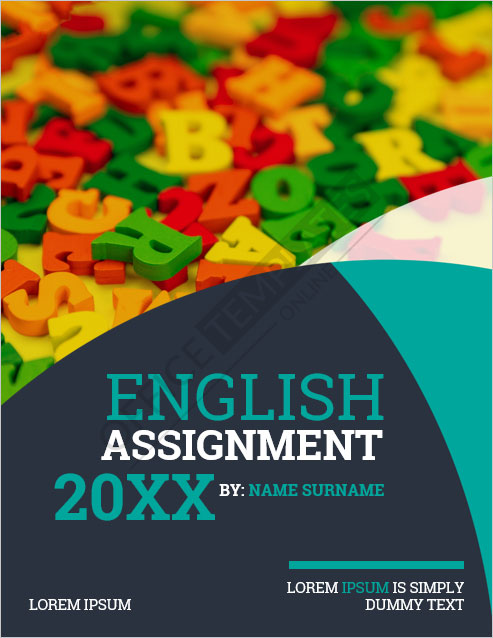
#23 – For Geography Projects
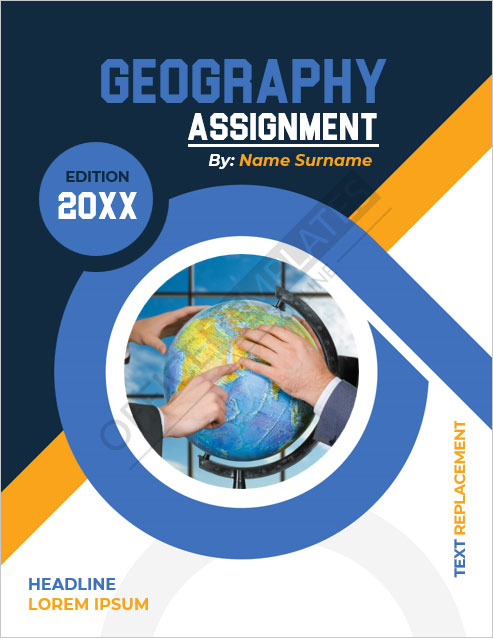
#24 – Mathematics
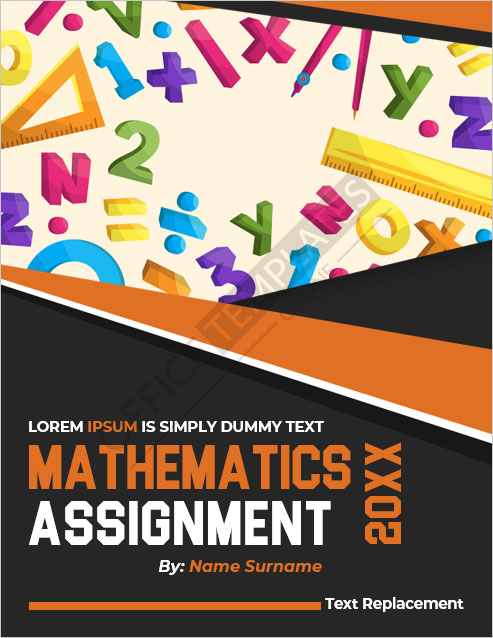
#25 – Physics
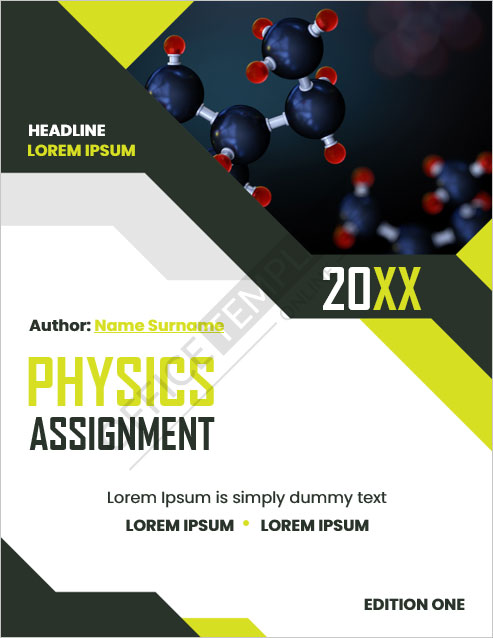
#26 – Cover Page for School Assignments

#27 – Best for Science Projects

#28 – For Social Study Assignment
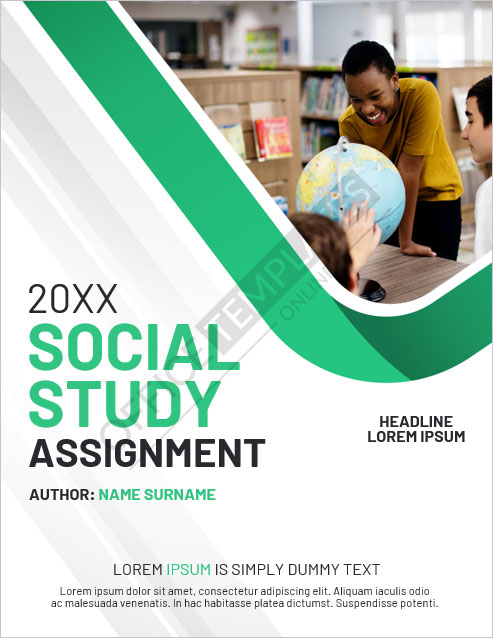
Versatile Designs and Layouts for Every Purpose
- Assignment Types: Our templates are designed specifically for different types of assignments, such as case studies, critical reviews, essays, syllabi, and business projects. Each template is tailored to suit the requirements and objectives of its respective assignment type.
- Academic Disciplines: Our collection includes templates suitable for various academic disciplines like biology, chemistry, computer science, engineering, English, geography, mathematics, physics, and social studies. Each template aligns with the themes and aesthetics of its corresponding discipline.
- Purposes: Whether you are a student, educator, or professional, our templates serve multiple purposes. They can be used for university assignments, school projects, research papers, or any academic or professional endeavor that requires a polished cover page.
- Designs, Layouts, and Styles: Our templates offer a diverse range of designs, from minimalistic and clean to visually captivating and sophisticated. You can choose from different layouts that creatively arrange text, images, and graphics. Our templates cater to a variety of styles, ensuring there is something for everyone’s preferences.
User-Friendly Customization: Make It Your Own
- Easy Modifications: We believe in keeping things simple. With just a few clicks, you can effortlessly modify our templates to suit your specific requirements. Change colors, fonts, and layouts with ease, and watch your cover page transform before your eyes.
- Colors and Themes: Infuse it with the perfect color scheme and themes that truly represent your assignment. Our templates offer a wide range of options, so you can find the ideal palette and theme that resonate with your content.
- Font Selection: The right font can make all the difference. Choose from our diverse selection of fonts to enhance the visual appeal and readability. From elegant and professional to modern and bold, we have fonts to suit every style.
- Layout Flexibility: It should reflect your unique presentation style. With our templates, you have the freedom to experiment with different layouts, arranging titles, subtitles, images, and text blocks in a way that best suits your assignment.
Benefits of Using Professionally Designed Templates: Make an Impact with Ease
- Time and Effort Saving: Our professionally designed templates eliminate the need to start from scratch. With pre-designed layouts, styles, and graphics, you can save valuable time and effort in creating visually appealing front pages. Simply customize the template to suit your assignment’s requirements, and you’re ready to impress.
- Consistency and Professionalism: Using our templates ensures consistency in your assignment submissions. The standardized design elements and formatting guidelines help maintain a professional appearance throughout your work. Presenting your assignments with a polished title page enhances the overall quality and credibility of your content.
- Visual Appeal: A visually appealing title page grabs attention and sets the tone for your assignment. Our templates are thoughtfully crafted by design professionals, incorporating aesthetically pleasing elements, color schemes, and typography. By leveraging these designs, you can effortlessly create eye-catching cover pages that captivate your professors or readers.
- Positive Impression: First impressions matter, and a well-designed cover page leaves a positive impact on professors and readers alike. Showcasing your assignment in a professional and visually appealing manner demonstrates your dedication and attention to detail. It sets the stage for an engaging reading experience, encouraging your audience to delve deeper into your work.
- User-Friendly Customization: Our templates are designed to be easily customizable, allowing you to add your personal touch without technical expertise. You can modify text, colors, images, and other elements to align with your assignment’s theme and requirements. This flexibility ensures that your cover page reflects your unique style while maintaining a professional look.
Tips for Maximizing the Impact: Make Your Cover Page Stand Out
- Choose Colors Wisely: Select colors that complement your assignment’s theme and evoke the desired emotions. Vibrant colors can grab attention, while muted tones create a sense of elegance. Maintain consistency with your assignment’s overall design and avoid using too many colors that may distract from the main message.
- Opt for Legible Fonts: Use clear and readable fonts to enhance the accessibility and professionalism of your cover page. Avoid overly decorative or complex fonts that may hinder readability. Opt for fonts that align with your assignment’s tone and maintain consistency throughout the document.
- Incorporate Relevant Graphics: Graphics can enhance the visual appeal of your cover page and reinforce the assignment’s subject matter. Choose images or icons that are directly related to the topic or convey the assignment’s main concept. Ensure that the graphics are high-quality and appropriately sized to maintain clarity.
- Organize Information Effectively: Arrange the information in a logical and visually appealing manner. Use headings, subheadings, and bullet points to break down content and make it easier to read. Highlight key details such as the assignment title, your name, course information, and submission date.
- Maintain Simplicity: While it’s important to make it visually appealing, avoid cluttering it with excessive elements. Keep the design clean and uncluttered, allowing the key information to stand out. Remember, simplicity often has a greater impact than complexity.
- Preview and Proofread: Before finalizing, preview it to ensure that all elements are properly aligned and visually balanced. Proofread the content to eliminate any spelling or grammatical errors. A polished and error-free cover demonstrates your attention to detail and professionalism.
← Previous Article
Next Article →
You may also like
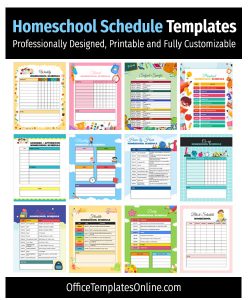
- Doctor Prescription Pad Formats
- Printable ID Cards
- Creative Resume Formats for Freshers
- Modern Resume Templates
- Best Cover Page Formats
- Printable Report Cards
- Business Proposal Templates
- 22 Raffle Ticket Templates
- Free Certificate Templates
- 18+ Free Purchase Order Templates to Organize Your Business Deals
- Organize, Learn, and Play with Free Homeschool Schedules!
- 5+ Free Food Diary Templates to Transform Your Eating Habits
- Make it Memorable: Free 4th of July Flyer Templates
- Say Goodbye with Style: Free Impactful Resignation Letter Templates
- Share Your Appreciation: Free Memorial Day Card Templates
- Crafted with Love: Free Mother’s Day Cards to Warm Mom’s Heart
- Stand Out from the Crowd: 14+ Free Fact Sheet Templates
- Make Your Mark: Free Printable Dog Name Tags for Every Tail-Wagger!
- 7+ Free Stunning Easter Templates for Joyful Celebrations
- 9+ Free Admit-One Ticket Templates: Flexible and Easy to Edit
- Get Cooking with Style: 8+ Free Customizable Recipe Card Templates
- Certificates
- Cover Pages
- Educational
- Event Templates
- Invoices & Receipts
- Letterheads
- Office Related
- Personal Use
- 137+ Professional Reports – MS Word & Excel
- 70+ Printable & Editable ID Card Designs
- 95+ Proposal Formats
- 31+ Best Flyer Designs & Formats
- 100+ Cover Page Templates
- 22+ Free Letterhead Designs and Formats
- 24+ Free Resume Designs & for Freshers and Professionals
- 136+ Printable Certificate Templates
- 55+ Quotations & Invoices
- Create FREE PDF Calendar Online
Home / Guides / Writing Guides / Parts of a Paper / How to Write an Essay Cover Page
How to Write an Essay Cover Page
What you include in your cover page depends slightly on which citation style you are using, but the rules are generally the same.
Guide Overview
- APA cover pages
- MLA cover pages
For APA cover pages:
Include the title of the paper, running head, the author’s name, institutional affiliation, and an author’s note.
Here is an example of a cover page in APA:

For MLA cover pages:
Cover pages are not as frequently used in MLA format, as the inclusion of headers is preferred.
A header looks like this:

Cover pages can include the name of your school, your paper title, your name, your course name, your teacher or professor’s name, and the due date of the paper. If you are unsure of what to include, check with your instructor.
Here is an example of a cover page in MLA format:

For more help making cover or title pages, visit our title page generator here.
EasyBib Writing Resources
Writing a paper.
- Academic Essay
- Argumentative Essay
- College Admissions Essay
- Expository Essay
- Persuasive Essay
- Research Paper
- Thesis Statement
- Writing a Conclusion
- Writing an Introduction
- Writing an Outline
- Writing a Summary
EasyBib Plus Features
- Citation Generator
- Essay Checker
- Expert Check Proofreader
- Grammar Checker
- Paraphrasing Tools
Plagiarism Checker
- Spell Checker
How useful was this post?
Click on a star to rate it!
We are sorry that this post was not useful for you!
Let us improve this post!
Tell us how we can improve this post?
Grammar and Plagiarism Checkers
Grammar Basics
Plagiarism Basics
Writing Basics
Upload a paper to check for plagiarism against billions of sources and get advanced writing suggestions for clarity and style.
Get Started
Free Front Page Design
Free Front Page Designs For Assignments And Projects [Download MS Word Templates]
A good front page design is important in a project because it makes a strong first impression. A well-designed cover page or front page can create a positive initial impression on the reader and set the tone for the rest of the project. It Conveys professionalism. A professional looking cover page demonstrates to the reader that the project has been completed with care and attention to detail.
The cover page should clearly communicate the title, author(s), and date of the project, as well as any other important information that the reader needs to know.
A well-designed cover page should reflect the content and tone of the project, helping to build a connection between the reader and the project’s contents.
In short, the cover page is a crucial component of a project and can have a significant impact on how the project is perceived and received by the reader.
Front Page Design Template Samples
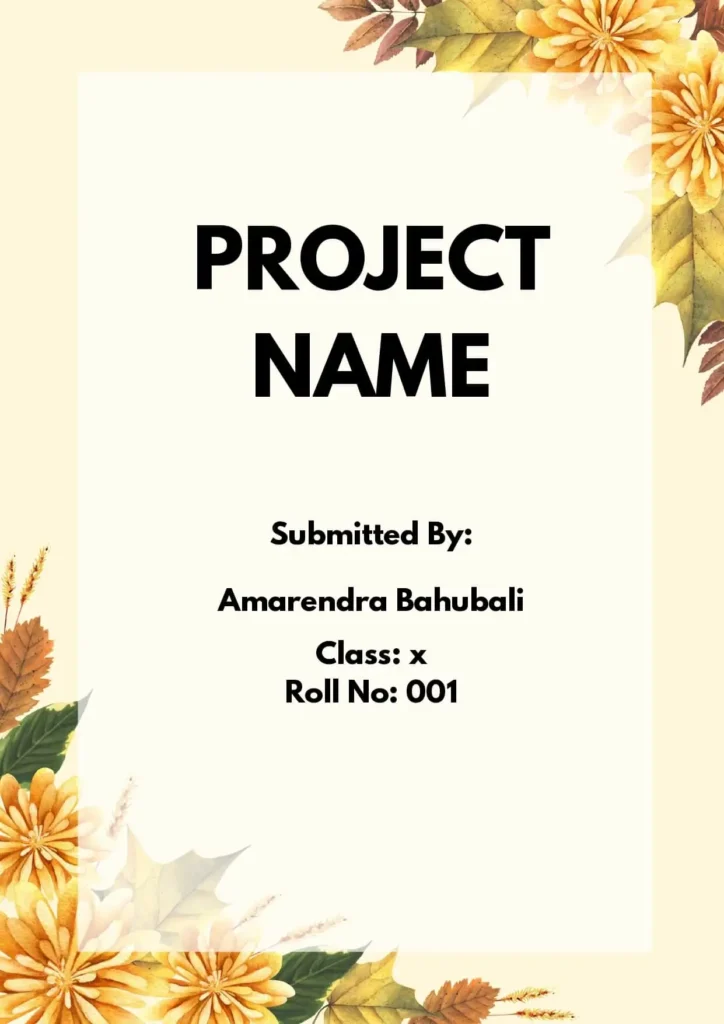
Benefits of using a good front page design on your project
- Establish a visual identity: A consistent and recognizable design on the cover page can help to establish a visual identity for the project and make it easier for the reader to identify it in the future.
- Differentiate the project: A unique and eye-catching cover page design can help to distinguish the project from others and make it stand out.
- Create a sense of unity: A well-designed cover page can provide a sense of unity to the entire project and reinforce the idea that all of the elements of the project are part of a cohesive whole.
- Provide context: The cover page design can provide context and information about the purpose, audience, and goals of the project, helping the reader to better understand and engage with the content.
- Improving organization: A well-designed cover page can help to organize the contents of the project and make it easier for the reader to navigate.
- Facilitating access: A clear and well-designed cover page can make it easier for the reader to access the contents of the project, and quickly find the information they are looking for.
- Enhancing accessibility: For projects that are shared electronically, a well-designed cover page can enhance accessibility for users with disabilities, such as those using screen readers.
Overall, a good cover page design is not just a cosmetic detail, but an important aspect of the project that can influence the reader’s perception and understanding of the content.
A well-designed front page can set the tone for the entire project and make it stand out from the rest. In this blog, we’ll take a look at some sample front page designs, best practices and tips to help you create a stunning front page design for your next project.
Front Page Designs Of Assignment
Front page designs for assignments [free ms word template download].
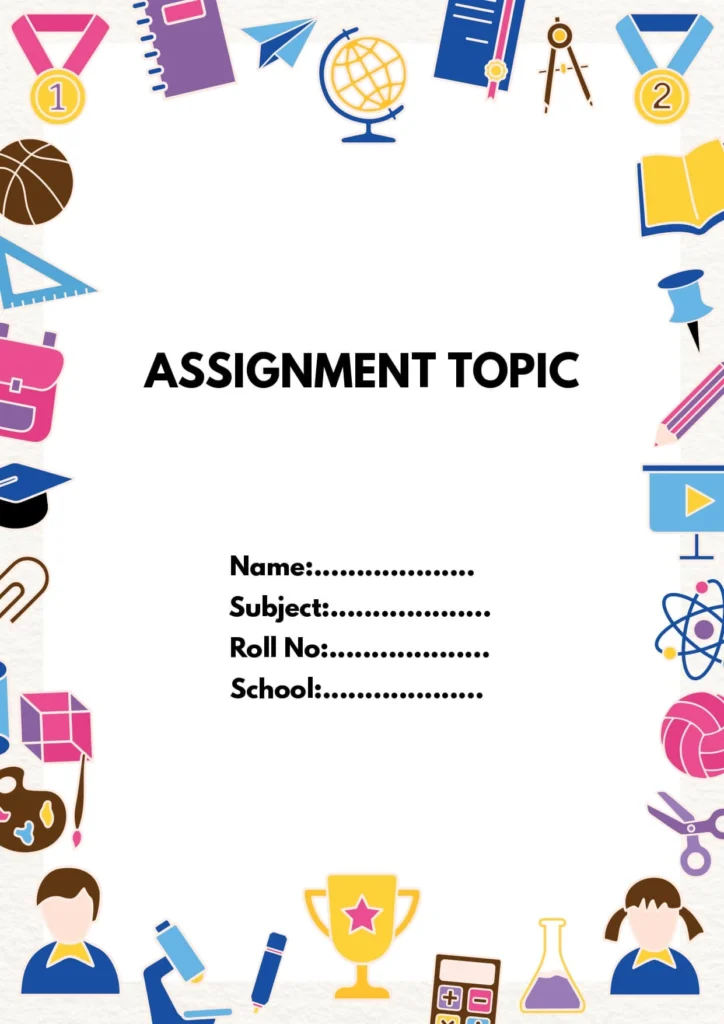
Creative Front Page Design For Assignment [Free MS Word Template Download]
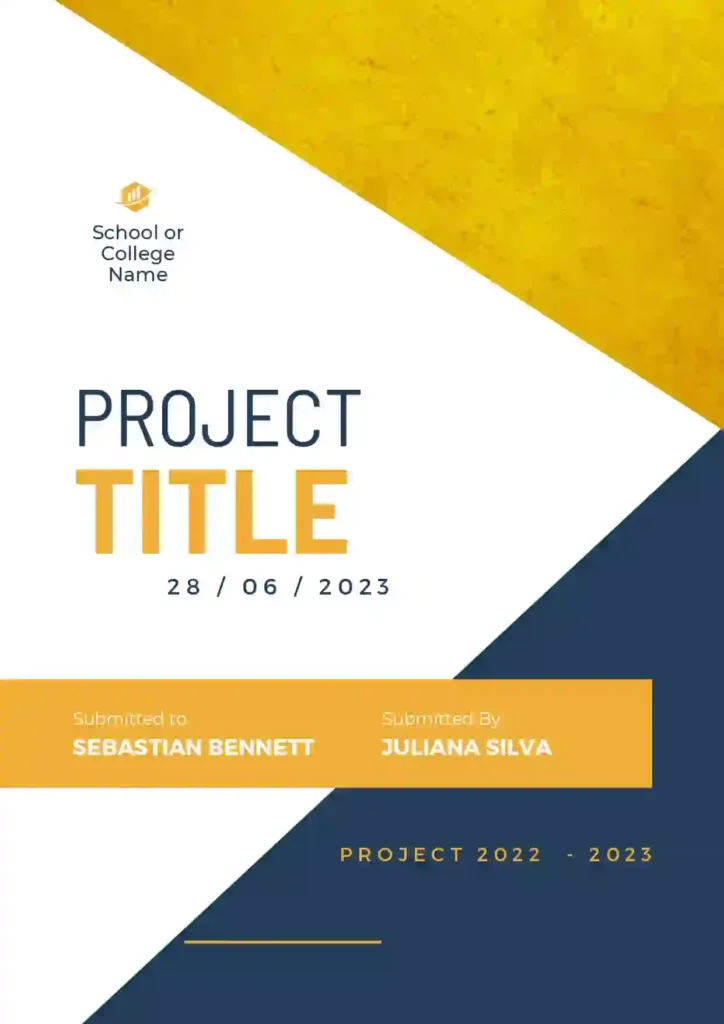
MORE ASSIGNMENT TEMPLATES
Tips for Stunning Front Page Design Of Assignment
While it’s important to keep the front page design simple, that doesn’t mean it can’t be creative. You can still add a touch of personality to your design while making sure it’s organized and professional.
Here are a few ideas to get you started:
- Use a unique font or color scheme
- Incorporate illustrations or graphics related to your project topic
- Experiment with different layout options
Science Project Front Page Design [Free MS Word Template Download]
When it comes to designing the front page for a science project, the design should reflect the topic and make the project stand out. You can include images or graphics related to the topic, and use a font that is easy to read.
Front Page Design For Physics Project

Front Page Design For Chemistry Project
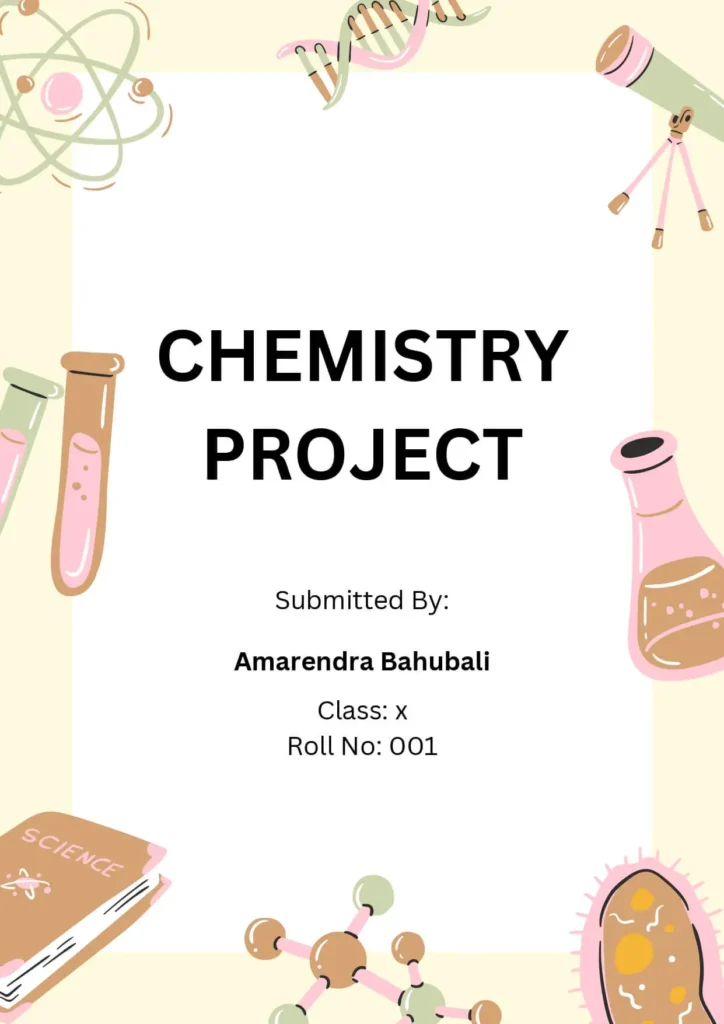
Front Page Design Tips For Chemistry Project
To design a cover page for a Chemistry project, you could try the following design concept:
- Use a light blue or green gradient to represent the chemical elements in a test tube.
- Use a bold sans-serif font, such as Arial or Verdana, to write the title of the project in white or yellow. Make the title the focal point of the page.
- Use a smaller sans-serif font, also in white or yellow, to write a brief description of the project, such as “An investigation into the properties of chemical reactions.”
- Use a smaller sans-serif font in black to write your name, class, and date of submission, positioned in the bottom right or left corner of the page.
- Add the logo of your school or university in the top right or left corner of the page.
- Include a relevant image or illustration of a chemical reaction, periodic table, or other scientific concept to reinforce the subject of Chemistry.
- Consider adding a simple white border around the entire page to give it structure and definition.
- This design concept incorporates elements of the subject of Chemistry, while also keeping it simple, clean, and professional.
Front Page Design For Biology Project
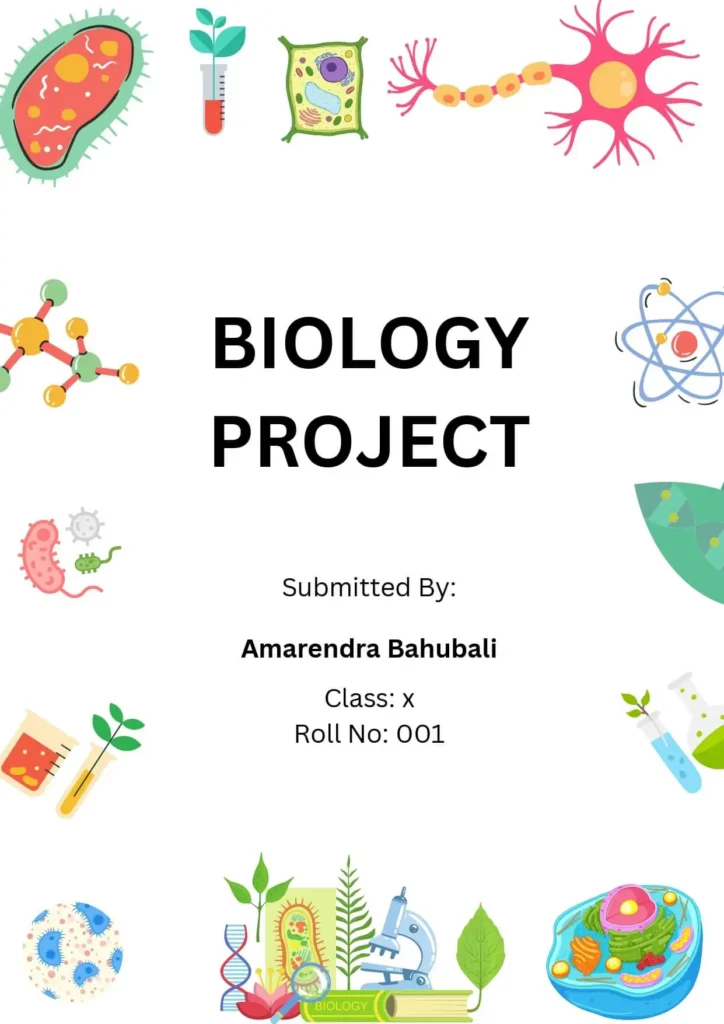
Front Page Design Tips For Biology Project
For a biology project cover page, you can consider incorporating the following elements:
- Title: A descriptive and concise title that accurately reflects the content of the project.
- Author(s): The name(s) of the person(s) who completed the project, usually in a prominent position on the page.
- Date: The date the project was completed, which is typically included in the header or footer of the page.
- School or organization: The name of the school, institution, or organization that the project was completed for, if applicable.
- Relevant images or graphics: Images or graphics related to the biology topic being studied, such as diagrams, charts, or photos of specimens.
- Project description: A brief summary or description of the project, including the purpose, methodology, and key findings.
- Aesthetics: A clean and professional design with a color palette that reflects the biology topic being studied. For example, green and blue might be appropriate for an aquatic biology project, while warm oranges and yellows might be appropriate for a botany project.
It’s important to note that the specific requirements for a biology project cover page can vary based on the guidelines provided by the teacher or institution. However, these elements can serve as a starting point for creating a visually appealing and effective design for a biology project cover page.
Border Front Page Design For Project [Free MS Word Template Download]
Adding a border to your front page design can help make it look more polished and professional. You can choose a border that reflects the topic of your project, or use a simple border in a neutral color.

Front Page Design For English Project [Free MS Word Template Download]
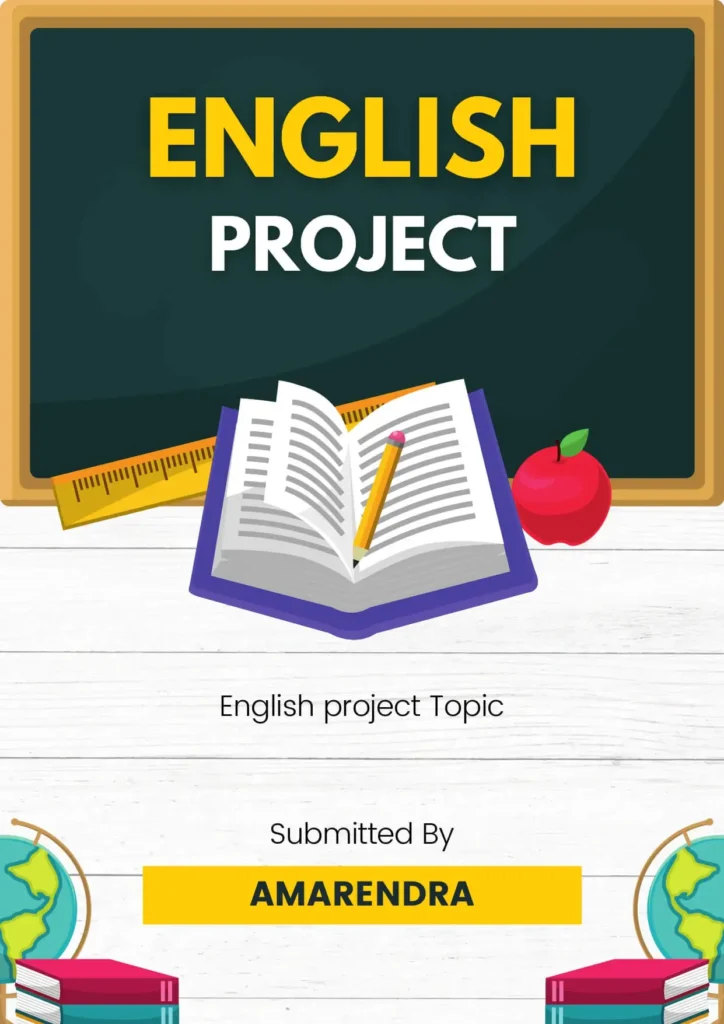
Front Page Design Tips For English Project
To design a cover page for an English project, you can consider the following steps:
- Choose a theme that aligns with the project topic and make it visually appealing.
- Add a title that clearly represents the project, it should be big and legible.
- Add your name, class, and date in a clear and concise manner.
- If required, include the name of your instructor and school/university.
- Add any relevant graphics, images, or logos that reinforce the theme of your project.
- Make sure to use a font that is easy to read and aesthetically pleasing.
- Consider adding a border or design element that ties everything together.
Note: The design should be professional and align with any guidelines provided by the instructor.
School Project Front Page Design
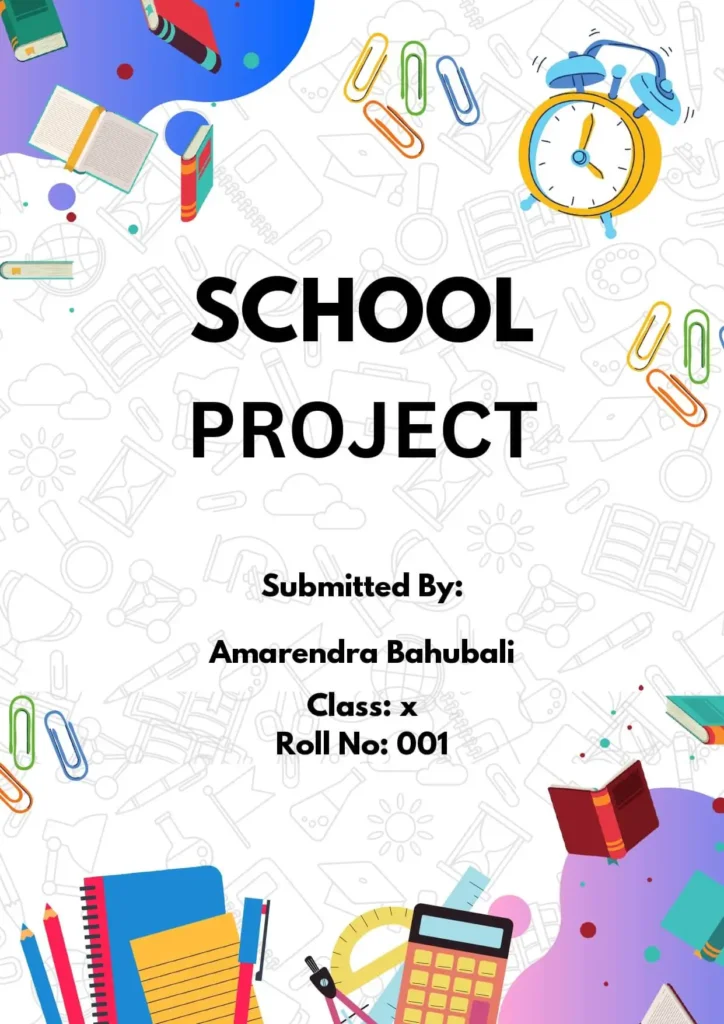
Floral Front Page Design For School Project
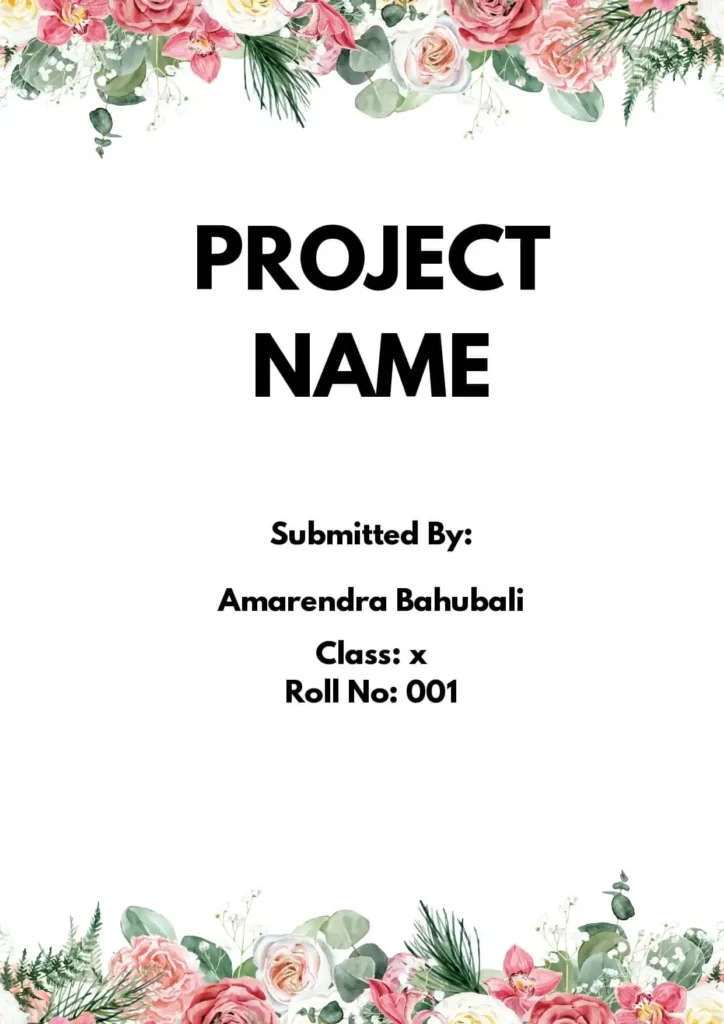
Whether or not it’s a good idea to use a floral front page design for a school project depends on the context of the project and the guidelines provided by the teacher or instructor. If the project is related to a subject such as art, design, or gardening, then a floral design may be appropriate. However, if the project is focused on a more technical or scientific subject, a more straightforward design may be more suitable. It’s important to consider the purpose and audience of the project and to ensure that the design effectively communicates the information you want to convey.
Cute Front Page Design For Project

Simple Front Page Designs For Project
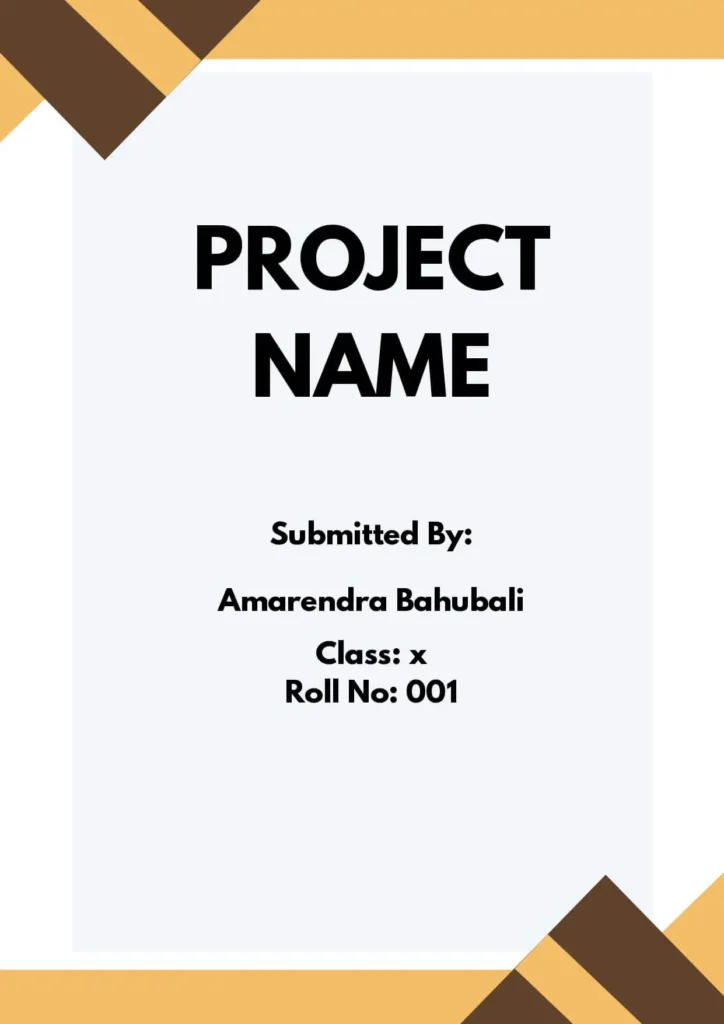
Front Page Designs For Math Project

Front Page Designs For Music Project
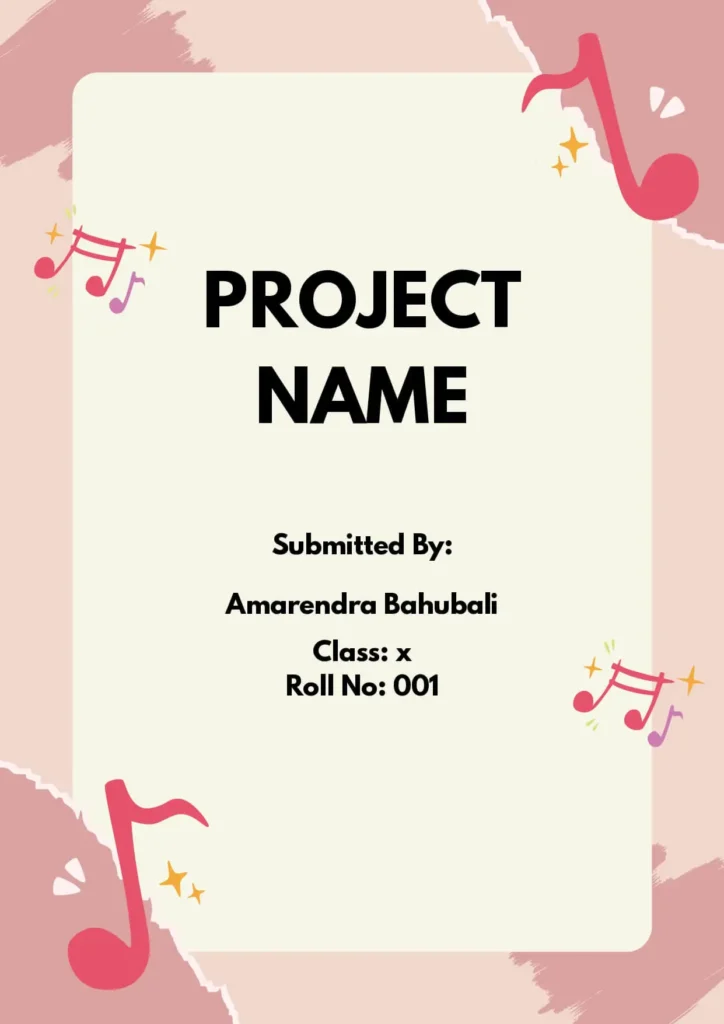
Handmade Front Page Design For Project
Tips to make your handmade front page designs more appealing .
A handmade cover page design can add a personal touch to your assignment and make it stand out. Here are some elements you could consider incorporating into your design:
- Hand-drawn illustrations or graphics: Use hand-drawn illustrations or graphics that are relevant to the subject matter of the assignment.
- Handwritten typography: Incorporate hand-written typography into your design to add a personal touch. Consider using a calligraphy pen or brush to create unique, hand-lettered text.
- Collage: Create a collage using different materials, such as paper, fabric, or photographs, to create a unique and visually interesting cover page design.
- Watercolor: Use watercolor to create a painted cover page design. Consider using colors that are consistent with the subject matter of the assignment.
By incorporating these elements, you can create a handmade cover page design that is both personal and professional. Keep in mind that a handmade design may take longer to create than a digital design, so be sure to allow enough time to complete it.
What are the best tools to create a beautiful Front Page Design for a project ?
There are many tools you can use to create a beautiful front page design for a project, including:
| It is a widely used word processing software developed by Microsoft. It provides users with tools to create and edit documents, including text, images, tables, and more. | |
| A professional-level desktop publishing software that is perfect for creating complex designs with multiple pages. | |
| : | An easy-to-use graphic design tool with a variety of templates and design elements for creating a front page design. |
| A desktop publishing software that comes as part of the Microsoft Office suite and is suitable for creating basic designs. | |
| : | A free and open-source image editing software that can be used for creating and editing graphics and images. |
| : | A cloud-based interface design tool that is suitable for creating front page designs and offers collaboration features for teams. |
| A vector graphics editor that is commonly used for designing user interfaces and user experiences. | |
| A vector graphics editor that is similar to Adobe Illustrator and provides a wide range of tools for creating graphics and designs. |
Here’s How You Can Create a Beautiful Front Page Design in MS Word:
- Choose a page size and orientation that suits your design. Go to Page Layout > Page Setup.
- Select a theme or color scheme. Go to Design > Colors.
- Add a header or footer for branding. Go to Insert > Header & Footer.
- Insert a title text box and customize its font, size, and color. Go to Insert > Text Box.
- Add an image to the background. Go to Insert > Picture.
- Add other design elements such as shapes, lines, or text boxes to create visual interest. Go to Insert > Shapes.
- Align and arrange elements as desired. Go to Home > Align.
- Apply styles to text, such as bold or italic, to make the page look more polished. Go to Home > Styles.
- Preview the page to check its appearance. Go to View > Print Layout.
- Save the document as a template to use as a starting point for future projects. Go to File > Save As > Word Template.
A good looking front page design for a school or assignment project or a science project is important because it reflects the attention and effort put into the project, and can impact the grade or evaluation received. A well-designed front page can also effectively convey the topic and purpose of the project, making it easier for the teacher or evaluator to understand and appreciate the content. A visually appealing and organized design can also make the project stand out, showing initiative and creativity, and can help the student effectively communicate their ideas and findings. In science projects, a clear and effective front page design can also help emphasize the significance and potential impact of the research. Ultimately, a good looking front page design can enhance the overall presentation and impact of the project.
What is the downloaded file format?
.doc (MS Word file extension)
How to edit the downloaded template?
Open it in MS Word and make changes according to your need.
What is the size of the template?
It is A4 size template.
Leave a Comment Cancel reply
Save my name, email, and website in this browser for the next time I comment.

Let's start a new assignment project together, Get Exclusive Free Assistance Now!

Need Help? Call Us :
- Assignment Writing Service
- Assignment Editing Service
- Assignment Masters
- Assignment Provider
- Buy Assignment Online
- Do My Assignment
- Assignment Writers
- College Assignment Help
- Essay Writing Service
- Online Essay Help
- Do My Essay
- Write My Essay
- Essay Assignment Help
- Essay Writer
- Essay Typer
- College Essay Help
- Essay Editor
- Types Of Essays
- Expository Essays
- Types Of Expository Essays
- Narrative Essays
- Narrative Essay Examples
- Narrative Essay Hooks
- Narrative Essay Childhood Memory
- Descriptive Essay About An Event
- Types Of Essays In Ielts
- Application Essay
- Argumentative Essay
- Essay Writing
- Essay Types
- Paper Writing Service
- Research Paper Help
- Term Paper Help
- Write My paper
- Paper Editor
- Research Proposal Help
- Thesis Writing Help
- Thesis Statement Help
- Homework Help
- Do My Homework
- Statistics Homework Help
- Physics Homework Help
- Word Problem Solver
- Accounting Homework Help
- Math Homework Help
- Solve my Math Problem
- College Homework Help
- Online Tutoring Service
- Algebra Homework Help
- CPM Homework Help
- Homework Answers
- Lab Report Help
- Pestel Analysis Help
- Business Report Help
- Book Review Help
- Book Report Help
- University Assignment Help
- Capstone Project Help
- Resume Writing Services
- Annotated Bibliography
- Ghostwriter
- Personal Statement Help
- Speech Writer
- Proofreading
- Assignment Help Australia
- Assignment Help United State
- Assignment Help UK
- Assignment Help Canada
- Assignment Help Singapore
- computation assignment help
- dbms assignment help
- microprocessor assignment help
- oracle assignment help
- pascal assignment help
- perl assignment help
- ruby assignment help
- sql assignment help
- uml assignment help
- web designing assignment help
- epidemiology assignment help
- nursing assignment help
- pharmacology assignment help
- psychology assignment help
- brand management assignment help
- construction management assignment help
- customer relationship management
- healthcare management assignment help
- mba assignment help
- myob assignment help
- recruitment assignment help
- strategy analysis assignment help
- pricing strategy assignment help
- business analytics assignment help
- business communication assignment help
- e commerce assignment help
- international finance assignment help
- quantitative analysis assignment help
- engineering mathematics assignment help
- civil engineering assignment help
- transportation assignment
- electronics assignment help
- geotechnical engineering assignment help
- telecommunication assignment help
- biomedical engineering assignment help
- mechanical engineering assignment help
- system analysis and design assignment help
- rationalism assignment help
- religion assignment help
- physics assignment help
- biology assignment help
- botany assignment help
- bioinformatics assignment help
- eviews assignment help
- linear programming assignment help
- minitab assignment help
- probability assignment help
- spss assignment help
- stata assignment help
- android assignment help
- c programing assignment help
- c sharp assignment help
- c plus plus assignment help
- fortran assignment help
- haskell assignment help
- html assignment help
- java assignment help
- python programming assignment help
- sap assignment help
- web programming assignment help
- Taxation Law Aassignment Help
- Constitutional Law Assignment help
- contract law assignment help
- civil law assignment help
- company law assignment help
- property law assignment help
- international law assignment help
- human rights law assignment help
- agriculture assignment help
- anthropology assignment help
- childcare assignment help
- english assignment help
- fashion assignment help
- music assignment help
- How It Works
- Assignment Help
Tips to Make The Attractive Assignments Front Page With Examples
The front page of your assignment file is as important as any other section of it. Although creating the front page is a simple step of the assignment writing process many times students do not pay much attention to its formatting and presentation. If created well, the assignment cover can surely put a great impact on your instructors and readers.
You should consider the cover page as a brief preview of your assignment. For those think how they can create an appealing title page they can consider taking assignment help from professionals assignment writers . They will provide exclusive templates to you based on your essay type . To begin with, let us have a look at some common yet important assignment front page format examples that can help you in making your cover page the best one.
Different Types of Assignment Front Page Design Samples
Standard assignment cover page.
An assignment title page includes some general information about the student, the subject, an assignment title, and the instructor’s name. In certain cases, the teachers provide a format for assignment cover. But if they do not you should make sure that you are including all the important fields.
The following sample depicts a standard format that you can use for your assignments. You can mention all your details here such as your name, subject details, assignment title, submission date, and due date. Another important thing in this sample is the declaration that your assignment is free from plagiarism.

Also Read : Assignment Cover Sheet Sample and Templates
Case Study Cover Page
A case study is an academic assignment that involves an in-depth analysis of a phenomenon or situation. In general, the format of a case study title page should include elements like title, institution’s name and presenter’s name(s). For your reference, consider the given front-page assignment sample for a case study.

Research Paper Cover Page
A research paper is written to present your arguments, findings, and solutions to a certain problem, social situation or trend. You can prepare the research paper for an academic community or you may do it as a part of your academic curriculum. The title page of an academic research paper includes the researcher’s name, the topic of the research, the supervisor’s name and university details of the student. It can also include a running head. The indentation and spacing of the cover page depend upon the referencing style student has chosen such as APA or MLA. Here is an example of the research paper cover page.

Book Cover Page Format
A book cover page generally includes the title of the book and the name of the author. You may provide an image or a one-line description of the book. Here is an example for you. You may see that this cover page also provide information about the publishers which is a good point to mention.

Lab Report Cover Page
Students often have to maintain a laboratory file in which they keep a record of all their experiments, observations and conclusions. You may easily prepare the lab report assignment front page format in Word and include all the necessary course details. Have a look at this example which contains a proper heading, the name of the department, student details such as course, semester, instructor’s details, lab details and also the details of the students who collectively prepared the report.

Article Review Title Page
It is another important assignment given to the students in which they have to understand someone else’s article and provide an accurate summation of the same. Sometimes students are asked to create a separate title page for this assignment and sometimes they just have to merge that with the assignment. Consider one of the article review assignment front page examples here. It doesn’t contain a separate title page yet it gives clear information to the reader about the topic, university details and the details of the reviewers.

Also Read: Experts Tips on College Assignment Formats & Structure with Examples
More Tips on Creating A Compelling Assignment Title Page
- If you want to make the front page of the assignment file more appealing you should consider using a template. It will allow you to place and present all the information correctly. This will be helpful in case you have no clue how to proceed with the cover page.
- Your cover page should always adhere to the referencing format you are following in the rest of your assignment. The presentations requirements of every referencing format vary hence make sure you are following that on the title page as well. Â For example, in APA referencing format the title of the page, appears somewhere in the middle of the page and is always aligned centre.
- Always go through some assignment front page design samples before creating your title page. This will make you familiar with what practices other students select to make their cover page look more presentable.
From the above examples, you might have observed that for different types of assignments, the requirements to create a cover page vary. Do seek assistance from an expert in case you face issues while designing the cover page. We provide the most authentic and buy assignment online to the students. So if you want to make a good first impression of your assignment, our assignment providers can provide you with an assignment front page format in Word based on your instructor’s guidelines and assignment requirements.
Need Help with assignments front page?
The first page of your assignment is also very critical when preparing an assignment. It must be imaginative and exclusive so that readers remain committed and connected to the overall assignment.
We at GoAssignmentHelp, a leading assignment help services with the best and experienced assignment Writers based in Brisbane operating online in Sydney , Melbourne , Perth , Canberra , Adelaide , Darwin and across the major cities of Australia can help you with assignment writing services in essays , research papers , thesis , dissertation , homework .
0 responses on "Tips to Make The Attractive Assignments Front Page With Examples"
Leave a message cancel reply.
Your email address will not be published. Required fields are marked *
Save my name, email, and website in this browser for the next time I comment.
Recent Posts
- PENN States Acceptance Rate of Admission
- ILAC Method: About, Importance, Components, and How to Write One!
- Math Skills with Derivative Calculator
- About ATAR Calculator: Calculation, Scores, Tips to Improve Your Grade and More!
- About Generic Conventions, Importance, Examples and more!

Securing Higher Grades is no more expensive!
We can help you boost your grades at best price., get exclusive 20% off.

[email protected] | (+1)617-933-5480
187 Wolf Road, Albany, New York, 12205, USA
100% Secure Payment

We offer assignment writing services in :
- Los Angeles
Disclaimer: Any material such as academic assignments, essays, articles, term and research papers, dissertations, coursework, case studies, PowerPoint presentations, reviews, etc. is solely for referential purposes. We do not encourage plagiarism in any form. We trust that our clients will use the provided material purely as a reference point in their own writing efforts.
GoAssignmentHelp Rated 4.4/5 based on 123 Reviews Copyright © 2010-2024 | www.goassignmenthelp.com | All rights reserved.

Tap to Chat
Get instant assignment help
How to Write a Perfect Assignment: Step-By-Step Guide
Table of contents
- 1 How to Structure an Assignment?
- 2.1 The research part
- 2.2 Planning your text
- 2.3 Writing major parts
- 3 Expert Tips for your Writing Assignment
- 4 Will I succeed with my assignments?
- 5 Conclusion
How to Structure an Assignment?
To cope with assignments, you should familiarize yourself with the tips on formatting and presenting assignments or any written paper, which are given below. It is worth paying attention to the content of the paper, making it structured and understandable so that ideas are not lost and thoughts do not refute each other.
If the topic is free or you can choose from the given list — be sure to choose the one you understand best. Especially if that could affect your semester score or scholarship. It is important to select an engaging title that is contextualized within your topic. A topic that should captivate you or at least give you a general sense of what is needed there. It’s easier to dwell upon what interests you, so the process goes faster.
To construct an assignment structure, use outlines. These are pieces of text that relate to your topic. It can be ideas, quotes, all your thoughts, or disparate arguments. Type in everything that you think about. Separate thoughts scattered across the sheets of Word will help in the next step.
Then it is time to form the text. At this stage, you have to form a coherent story from separate pieces, where each new thought reinforces the previous one, and one idea smoothly flows into another.
Main Steps of Assignment Writing
These are steps to take to get a worthy paper. If you complete these step-by-step, your text will be among the most exemplary ones.
The research part
If the topic is unique and no one has written about it yet, look at materials close to this topic to gain thoughts about it. You should feel that you are ready to express your thoughts. Also, while reading, get acquainted with the format of the articles, study the details, collect material for your thoughts, and accumulate different points of view for your article. Be careful at this stage, as the process can help you develop your ideas. If you are already struggling here, pay for assignment to be done , and it will be processed in a split second via special services. These services are especially helpful when the deadline is near as they guarantee fast delivery of high-quality papers on any subject.
If you use Google to search for material for your assignment, you will, of course, find a lot of information very quickly. Still, the databases available on your library’s website will give you the clearest and most reliable facts that satisfy your teacher or professor. Be sure you copy the addresses of all the web pages you will use when composing your paper, so you don’t lose them. You can use them later in your bibliography if you add a bit of description! Select resources and extract quotes from them that you can use while working. At this stage, you may also create a request for late assignment if you realize the paper requires a lot of effort and is time-consuming. This way, you’ll have a backup plan if something goes wrong.
Planning your text
Assemble a layout. It may be appropriate to use the structure of the paper of some outstanding scientists in your field and argue it in one of the parts. As the planning progresses, you can add suggestions that come to mind. If you use citations that require footnotes, and if you use single spacing throughout the paper and double spacing at the end, it will take you a very long time to make sure that all the citations are on the exact pages you specified! Add a reference list or bibliography. If you haven’t already done so, don’t put off writing an essay until the last day. It will be more difficult to do later as you will be stressed out because of time pressure.
Writing major parts
It happens that there is simply no mood or strength to get started and zero thoughts. In that case, postpone this process for 2-3 hours, and, perhaps, soon, you will be able to start with renewed vigor. Writing essays is a great (albeit controversial) way to improve your skills. This experience will not be forgotten. It will certainly come in handy and bring many benefits in the future. Do your best here because asking for an extension is not always possible, so you probably won’t have time to redo it later. And the quality of this part defines the success of the whole paper.
Writing the major part does not mean the matter is finished. To review the text, make sure that the ideas of the introduction and conclusion coincide because such a discrepancy is the first thing that will catch the reader’s eye and can spoil the impression. Add or remove anything from your intro to edit it to fit the entire paper. Also, check your spelling and grammar to ensure there are no typos or draft comments. Check the sources of your quotes so that your it is honest and does not violate any rules. And do not forget the formatting rules.
with the right tips and guidance, it can be easier than it looks. To make the process even more straightforward, students can also use an assignment service to get the job done. This way they can get professional assistance and make sure that their assignments are up to the mark. At PapersOwl, we provide a professional writing service where students can order custom-made assignments that meet their exact requirements.
Expert Tips for your Writing Assignment
Want to write like a pro? Here’s what you should consider:
- Save the document! Send the finished document by email to yourself so you have a backup copy in case your computer crashes.
- Don’t wait until the last minute to complete a list of citations or a bibliography after the paper is finished. It will be much longer and more difficult, so add to them as you go.
- If you find a lot of information on the topic of your search, then arrange it in a separate paragraph.
- If possible, choose a topic that you know and are interested in.
- Believe in yourself! If you set yourself up well and use your limited time wisely, you will be able to deliver the paper on time.
- Do not copy information directly from the Internet without citing them.
Writing assignments is a tedious and time-consuming process. It requires a lot of research and hard work to produce a quality paper. However, if you are feeling overwhelmed or having difficulty understanding the concept, you may want to consider getting accounting homework help online . Professional experts can assist you in understanding how to complete your assignment effectively. PapersOwl.com offers expert help from highly qualified and experienced writers who can provide you with the homework help you need.
Will I succeed with my assignments?
Anyone can learn how to be good at writing: follow simple rules of creating the structure and be creative where it is appropriate. At one moment, you will need some additional study tools, study support, or solid study tips. And you can easily get help in writing assignments or any other work. This is especially useful since the strategy of learning how to write an assignment can take more time than a student has.
Therefore all students are happy that there is an option to order your paper at a professional service to pass all the courses perfectly and sleep still at night. You can also find the sample of the assignment there to check if you are on the same page and if not — focus on your papers more diligently.
So, in the times of studies online, the desire and skill to research and write may be lost. Planning your assignment carefully and presenting arguments step-by-step is necessary to succeed with your homework. When going through your references, note the questions that appear and answer them, building your text. Create a cover page, proofread the whole text, and take care of formatting. Feel free to use these rules for passing your next assignments.
When it comes to writing an assignment, it can be overwhelming and stressful, but Papersowl is here to make it easier for you. With a range of helpful resources available, Papersowl can assist you in creating high-quality written work, regardless of whether you’re starting from scratch or refining an existing draft. From conducting research to creating an outline, and from proofreading to formatting, the team at Papersowl has the expertise to guide you through the entire writing process and ensure that your assignment meets all the necessary requirements.
Readers also enjoyed

WHY WAIT? PLACE AN ORDER RIGHT NOW!
Just fill out the form, press the button, and have no worries!
We use cookies to give you the best experience possible. By continuing we’ll assume you board with our cookie policy.

Title Page Setup
A title page is required for all APA Style papers. There are both student and professional versions of the title page. Students should use the student version of the title page unless their instructor or institution has requested they use the professional version. APA provides a student title page guide (PDF, 199KB) to assist students in creating their title pages.
Student title page
The student title page includes the paper title, author names (the byline), author affiliation, course number and name for which the paper is being submitted, instructor name, assignment due date, and page number, as shown in this example.

Title page setup is covered in the seventh edition APA Style manuals in the Publication Manual Section 2.3 and the Concise Guide Section 1.6
Related handouts
- Student Title Page Guide (PDF, 263KB)
- Student Paper Setup Guide (PDF, 3MB)
Student papers do not include a running head unless requested by the instructor or institution.
Follow the guidelines described next to format each element of the student title page.
|
|
|
|
|---|---|---|
| Paper title | Place the title three to four lines down from the top of the title page. Center it and type it in bold font. Capitalize of the title. Place the main title and any subtitle on separate double-spaced lines if desired. There is no maximum length for titles; however, keep titles focused and include key terms. |
|
| Author names | Place one double-spaced blank line between the paper title and the author names. Center author names on their own line. If there are two authors, use the word “and” between authors; if there are three or more authors, place a comma between author names and use the word “and” before the final author name. | Cecily J. Sinclair and Adam Gonzaga |
| Author affiliation | For a student paper, the affiliation is the institution where the student attends school. Include both the name of any department and the name of the college, university, or other institution, separated by a comma. Center the affiliation on the next double-spaced line after the author name(s). | Department of Psychology, University of Georgia |
| Course number and name | Provide the course number as shown on instructional materials, followed by a colon and the course name. Center the course number and name on the next double-spaced line after the author affiliation. | PSY 201: Introduction to Psychology |
| Instructor name | Provide the name of the instructor for the course using the format shown on instructional materials. Center the instructor name on the next double-spaced line after the course number and name. | Dr. Rowan J. Estes |
| Assignment due date | Provide the due date for the assignment. Center the due date on the next double-spaced line after the instructor name. Use the date format commonly used in your country. | October 18, 2020 |
|
| Use the page number 1 on the title page. Use the automatic page-numbering function of your word processing program to insert page numbers in the top right corner of the page header. | 1 |
Professional title page
The professional title page includes the paper title, author names (the byline), author affiliation(s), author note, running head, and page number, as shown in the following example.

Follow the guidelines described next to format each element of the professional title page.
|
|
|
|
|---|---|---|
| Paper title | Place the title three to four lines down from the top of the title page. Center it and type it in bold font. Capitalize of the title. Place the main title and any subtitle on separate double-spaced lines if desired. There is no maximum length for titles; however, keep titles focused and include key terms. |
|
| Author names
| Place one double-spaced blank line between the paper title and the author names. Center author names on their own line. If there are two authors, use the word “and” between authors; if there are three or more authors, place a comma between author names and use the word “and” before the final author name. | Francesca Humboldt |
| When different authors have different affiliations, use superscript numerals after author names to connect the names to the appropriate affiliation(s). If all authors have the same affiliation, superscript numerals are not used (see Section 2.3 of the for more on how to set up bylines and affiliations). | Tracy Reuter , Arielle Borovsky , and Casey Lew-Williams | |
| Author affiliation
| For a professional paper, the affiliation is the institution at which the research was conducted. Include both the name of any department and the name of the college, university, or other institution, separated by a comma. Center the affiliation on the next double-spaced line after the author names; when there are multiple affiliations, center each affiliation on its own line.
| Department of Nursing, Morrigan University |
| When different authors have different affiliations, use superscript numerals before affiliations to connect the affiliations to the appropriate author(s). Do not use superscript numerals if all authors share the same affiliations (see Section 2.3 of the for more). | Department of Psychology, Princeton University | |
| Author note | Place the author note in the bottom half of the title page. Center and bold the label “Author Note.” Align the paragraphs of the author note to the left. For further information on the contents of the author note, see Section 2.7 of the . | n/a |
|
| The running head appears in all-capital letters in the page header of all pages, including the title page. Align the running head to the left margin. Do not use the label “Running head:” before the running head. | Prediction errors support children’s word learning |
|
| Use the page number 1 on the title page. Use the automatic page-numbering function of your word processing program to insert page numbers in the top right corner of the page header. | 1 |
- Mailing List
- Search Search
Username or Email Address
Remember Me

Resources for Teachers: Creating Writing Assignments
This page contains four specific areas:
Creating Effective Assignments
Checking the assignment, sequencing writing assignments, selecting an effective writing assignment format.
Research has shown that the more detailed a writing assignment is, the better the student papers are in response to that assignment. Instructors can often help students write more effective papers by giving students written instructions about that assignment. Explicit descriptions of assignments on the syllabus or on an “assignment sheet” tend to produce the best results. These instructions might make explicit the process or steps necessary to complete the assignment. Assignment sheets should detail:
- the kind of writing expected
- the scope of acceptable subject matter
- the length requirements
- formatting requirements
- documentation format
- the amount and type of research expected (if any)
- the writer’s role
- deadlines for the first draft and its revision
Providing questions or needed data in the assignment helps students get started. For instance, some questions can suggest a mode of organization to the students. Other questions might suggest a procedure to follow. The questions posed should require that students assert a thesis.
The following areas should help you create effective writing assignments.
Examining your goals for the assignment
- How exactly does this assignment fit with the objectives of your course?
- Should this assignment relate only to the class and the texts for the class, or should it also relate to the world beyond the classroom?
- What do you want the students to learn or experience from this writing assignment?
- Should this assignment be an individual or a collaborative effort?
- What do you want students to show you in this assignment? To demonstrate mastery of concepts or texts? To demonstrate logical and critical thinking? To develop an original idea? To learn and demonstrate the procedures, practices, and tools of your field of study?
Defining the writing task
- Is the assignment sequenced so that students: (1) write a draft, (2) receive feedback (from you, fellow students, or staff members at the Writing and Communication Center), and (3) then revise it? Such a procedure has been proven to accomplish at least two goals: it improves the student’s writing and it discourages plagiarism.
- Does the assignment include so many sub-questions that students will be confused about the major issue they should examine? Can you give more guidance about what the paper’s main focus should be? Can you reduce the number of sub-questions?
- What is the purpose of the assignment (e.g., review knowledge already learned, find additional information, synthesize research, examine a new hypothesis)? Making the purpose(s) of the assignment explicit helps students write the kind of paper you want.
- What is the required form (e.g., expository essay, lab report, memo, business report)?
- What mode is required for the assignment (e.g., description, narration, analysis, persuasion, a combination of two or more of these)?
Defining the audience for the paper
- Can you define a hypothetical audience to help students determine which concepts to define and explain? When students write only to the instructor, they may assume that little, if anything, requires explanation. Defining the whole class as the intended audience will clarify this issue for students.
- What is the probable attitude of the intended readers toward the topic itself? Toward the student writer’s thesis? Toward the student writer?
- What is the probable educational and economic background of the intended readers?
Defining the writer’s role
- Can you make explicit what persona you wish the students to assume? For example, a very effective role for student writers is that of a “professional in training” who uses the assumptions, the perspective, and the conceptual tools of the discipline.
Defining your evaluative criteria
1. If possible, explain the relative weight in grading assigned to the quality of writing and the assignment’s content:
- depth of coverage
- organization
- critical thinking
- original thinking
- use of research
- logical demonstration
- appropriate mode of structure and analysis (e.g., comparison, argument)
- correct use of sources
- grammar and mechanics
- professional tone
- correct use of course-specific concepts and terms.
Here’s a checklist for writing assignments:
- Have you used explicit command words in your instructions (e.g., “compare and contrast” and “explain” are more explicit than “explore” or “consider”)? The more explicit the command words, the better chance the students will write the type of paper you wish.
- Does the assignment suggest a topic, thesis, and format? Should it?
- Have you told students the kind of audience they are addressing — the level of knowledge they can assume the readers have and your particular preferences (e.g., “avoid slang, use the first-person sparingly”)?
- If the assignment has several stages of completion, have you made the various deadlines clear? Is your policy on due dates clear?
- Have you presented the assignment in a manageable form? For instance, a 5-page assignment sheet for a 1-page paper may overwhelm students. Similarly, a 1-sentence assignment for a 25-page paper may offer insufficient guidance.
There are several benefits of sequencing writing assignments:
- Sequencing provides a sense of coherence for the course.
- This approach helps students see progress and purpose in their work rather than seeing the writing assignments as separate exercises.
- It encourages complexity through sustained attention, revision, and consideration of multiple perspectives.
- If you have only one large paper due near the end of the course, you might create a sequence of smaller assignments leading up to and providing a foundation for that larger paper (e.g., proposal of the topic, an annotated bibliography, a progress report, a summary of the paper’s key argument, a first draft of the paper itself). This approach allows you to give students guidance and also discourages plagiarism.
- It mirrors the approach to written work in many professions.
The concept of sequencing writing assignments also allows for a wide range of options in creating the assignment. It is often beneficial to have students submit the components suggested below to your course’s STELLAR web site.
Use the writing process itself. In its simplest form, “sequencing an assignment” can mean establishing some sort of “official” check of the prewriting and drafting steps in the writing process. This step guarantees that students will not write the whole paper in one sitting and also gives students more time to let their ideas develop. This check might be something as informal as having students work on their prewriting or draft for a few minutes at the end of class. Or it might be something more formal such as collecting the prewriting and giving a few suggestions and comments.
Have students submit drafts. You might ask students to submit a first draft in order to receive your quick responses to its content, or have them submit written questions about the content and scope of their projects after they have completed their first draft.
Establish small groups. Set up small writing groups of three-five students from the class. Allow them to meet for a few minutes in class or have them arrange a meeting outside of class to comment constructively on each other’s drafts. The students do not need to be writing on the same topic.
Require consultations. Have students consult with someone in the Writing and Communication Center about their prewriting and/or drafts. The Center has yellow forms that we can give to students to inform you that such a visit was made.
Explore a subject in increasingly complex ways. A series of reading and writing assignments may be linked by the same subject matter or topic. Students encounter new perspectives and competing ideas with each new reading, and thus must evaluate and balance various views and adopt a position that considers the various points of view.
Change modes of discourse. In this approach, students’ assignments move from less complex to more complex modes of discourse (e.g., from expressive to analytic to argumentative; or from lab report to position paper to research article).
Change audiences. In this approach, students create drafts for different audiences, moving from personal to public (e.g., from self-reflection to an audience of peers to an audience of specialists). Each change would require different tasks and more extensive knowledge.
Change perspective through time. In this approach, students might write a statement of their understanding of a subject or issue at the beginning of a course and then return at the end of the semester to write an analysis of that original stance in the light of the experiences and knowledge gained in the course.
Use a natural sequence. A different approach to sequencing is to create a series of assignments culminating in a final writing project. In scientific and technical writing, for example, students could write a proposal requesting approval of a particular topic. The next assignment might be a progress report (or a series of progress reports), and the final assignment could be the report or document itself. For humanities and social science courses, students might write a proposal requesting approval of a particular topic, then hand in an annotated bibliography, and then a draft, and then the final version of the paper.
Have students submit sections. A variation of the previous approach is to have students submit various sections of their final document throughout the semester (e.g., their bibliography, review of the literature, methods section).
In addition to the standard essay and report formats, several other formats exist that might give students a different slant on the course material or allow them to use slightly different writing skills. Here are some suggestions:
Journals. Journals have become a popular format in recent years for courses that require some writing. In-class journal entries can spark discussions and reveal gaps in students’ understanding of the material. Having students write an in-class entry summarizing the material covered that day can aid the learning process and also reveal concepts that require more elaboration. Out-of-class entries involve short summaries or analyses of texts, or are a testing ground for ideas for student papers and reports. Although journals may seem to add a huge burden for instructors to correct, in fact many instructors either spot-check journals (looking at a few particular key entries) or grade them based on the number of entries completed. Journals are usually not graded for their prose style. STELLAR forums work well for out-of-class entries.
Letters. Students can define and defend a position on an issue in a letter written to someone in authority. They can also explain a concept or a process to someone in need of that particular information. They can write a letter to a friend explaining their concerns about an upcoming paper assignment or explaining their ideas for an upcoming paper assignment. If you wish to add a creative element to the writing assignment, you might have students adopt the persona of an important person discussed in your course (e.g., an historical figure) and write a letter explaining his/her actions, process, or theory to an interested person (e.g., “pretend that you are John Wilkes Booth and write a letter to the Congress justifying your assassination of Abraham Lincoln,” or “pretend you are Henry VIII writing to Thomas More explaining your break from the Catholic Church”).
Editorials . Students can define and defend a position on a controversial issue in the format of an editorial for the campus or local newspaper or for a national journal.
Cases . Students might create a case study particular to the course’s subject matter.
Position Papers . Students can define and defend a position, perhaps as a preliminary step in the creation of a formal research paper or essay.
Imitation of a Text . Students can create a new document “in the style of” a particular writer (e.g., “Create a government document the way Woody Allen might write it” or “Write your own ‘Modest Proposal’ about a modern issue”).
Instruction Manuals . Students write a step-by-step explanation of a process.
Dialogues . Students create a dialogue between two major figures studied in which they not only reveal those people’s theories or thoughts but also explore areas of possible disagreement (e.g., “Write a dialogue between Claude Monet and Jackson Pollock about the nature and uses of art”).
Collaborative projects . Students work together to create such works as reports, questions, and critiques.
Generate accurate APA citations for free
- Knowledge Base
- APA Style 7th edition
- APA Title Page (7th edition) | Template for Students & Professionals
APA Title Page (7th edition) | Template for Students & Professionals
Published on November 6, 2020 by Raimo Streefkerk . Revised on January 17, 2024.
APA provides different guidelines for student and professional papers. The student version of the APA title page should include the following information (double spaced and centered):
Paper title
- Author name
- Department and university name
- Course number and name
- Instructor name
- Due date of the assignment
The professional title page also includes an author note (flushed left), but not a course name, instructor name, or due date.
Instantly correct all language mistakes in your text
Upload your document to correct all your mistakes in minutes

Table of contents
Title page example (student and professional version), institutional affiliation, course information, author note, page header, including an image on the title page.

Scribbr Citation Checker New
The AI-powered Citation Checker helps you avoid common mistakes such as:
- Missing commas and periods
- Incorrect usage of “et al.”
- Ampersands (&) in narrative citations
- Missing reference entries

Write an informative, striking title that summarizes the topic of your paper. Try to keep the title focused and use relevant keywords.
Place the title three or four lines down from the top of the paper. Center align and bold it. Don’t forget to use title case capitalization (capitalize the first letter of each word, except small words such as articles and short prepositions).
Write the author’s name under the paper title (leave a blank line in between). Give their full names (first name, middle initial(s) and last name), but don’t include titles (Dr., Prof.) or degrees (Ph.D., MSc).
Multiple authors on the title page
List the authors in order of their contribution. If there are two authors, separate their names with the word “and”, like this:
If there are more than two authors, separate their names with a comma. Only write “and” before the last author, like this:
Write the author’s affiliation on the next line under the author names. Students should specify the department and institution where they’re attending school. Professional researchers should specify the department and institution where they conducted their research.
Multiple authors with different affiliations
Use superscript numbers on the author line to indicate which institution they’re affiliated with. Don’t use superscript numbers if all authors are affiliated with the same institution (and department).
Prevent plagiarism. Run a free check.
On a student title page, provide information about the course. List the following information on separate (double spaced) lines under the author’s affiliation:
- Instructor(s)
- Assignment’s due date
For professional papers, you may include an author note. This note may contain the author’s ORCID iD, affiliation changes, disclosures of conflicts of interest, brief acknowledgments, and contact information (in that specific order). Present this information in separate paragraphs.
Place the author note on the bottom half of the page. Center the label “Author note” and apply bold styling. The paragraphs in the author note are left-aligned. The first line of each new paragraph is indented.
For more information about formatting the author note, see section 2.7 of the APA Publication Manual.
For a student title page, the page header consists of just a page number in the top-right corner. There is no need for a running head (as was the case in APA 6th edition).
A professional title page does have a running head. The running head is an abbreviated version of the paper title in all capital letters. The maximum length is 50 characters (counting spaces).
Images are not usually included on an APA title page, and APA does not provide any guidelines for doing so. It’s usually viewed as unprofessional to include an image, since the title page is there to provide information, not for decoration.
If you do decide to include an image on your title page, make sure to check whether you need permission from the creator of the image. Include a note directly underneath the image acknowledging where it comes from, beginning with the word “ Note .” (italicized and followed by a period):
- If you found the image online or in another source, include a citation and copyright attribution .
- If it’s an image you created yourself (e.g., a photograph you took, an infographic you designed), explain this (e.g., “Photograph taken by the author.”).
Don’t give the image a label, title, or number. Only images within the text itself are labeled as figures .
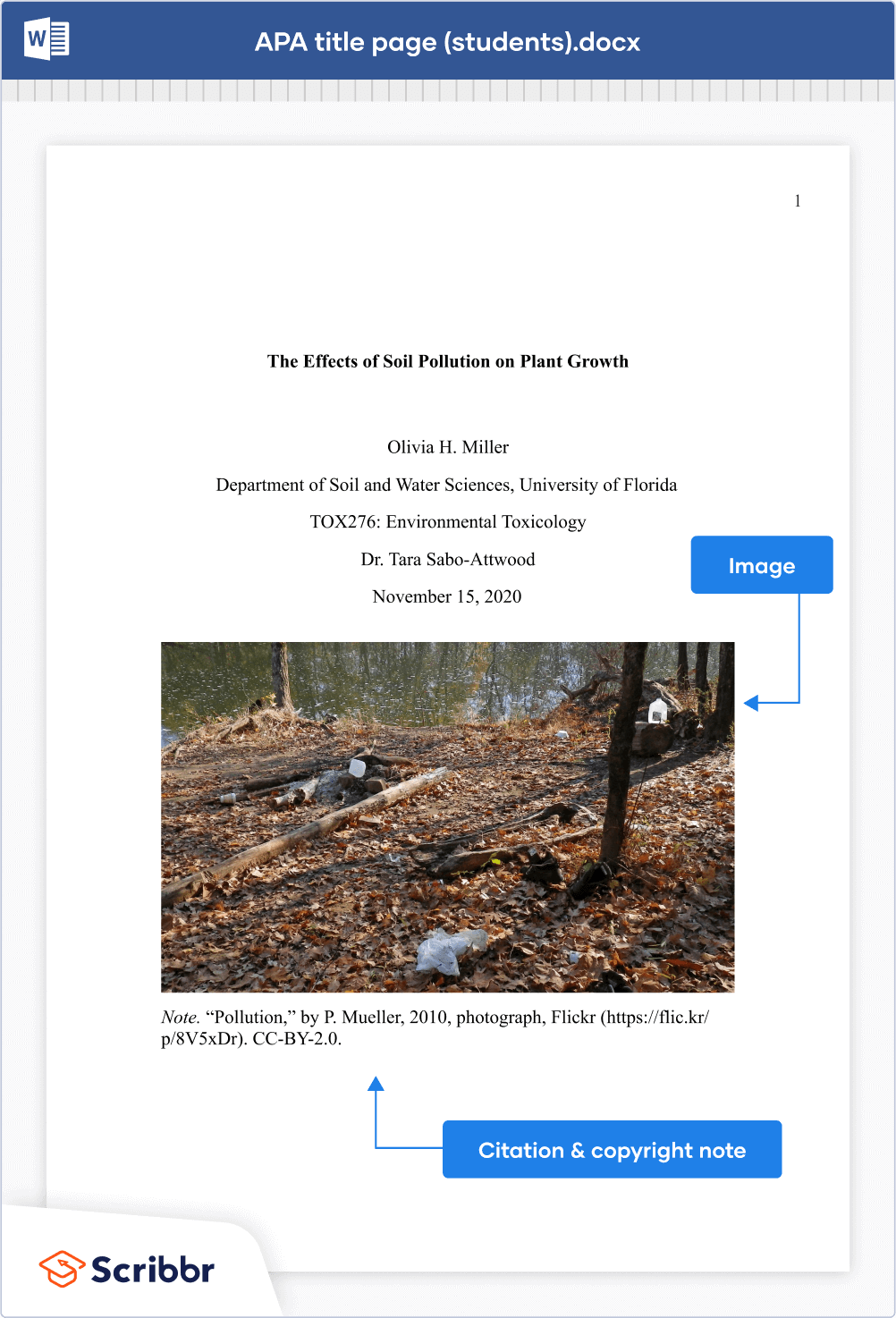
Cite this Scribbr article
If you want to cite this source, you can copy and paste the citation or click the “Cite this Scribbr article” button to automatically add the citation to our free Citation Generator.
Streefkerk, R. (2024, January 17). APA Title Page (7th edition) | Template for Students & Professionals. Scribbr. Retrieved September 30, 2024, from https://www.scribbr.com/apa-style/apa-title-page/
Is this article helpful?
Raimo Streefkerk
Other students also liked, apa headings and subheadings, forging good titles in academic writing, apa running head, "i thought ai proofreading was useless but..".
I've been using Scribbr for years now and I know it's a service that won't disappoint. It does a good job spotting mistakes”
MS Word Cover Page Templates
Download, personalize & print, assignment first page design templates.
Posted By: admin 14/02/2019
Assignment cover page is a one-page document that bears the heading of the argument that is to be discussed and all the vital details of the person who has managed to jot down the material in the allotted time.
The best way to bring your assignment into notice is to make your cover page catchy and fascinating, the one that makes the examiner curious about the content inside it, positively compels him to turn the page and dig the master writing piece of yours.
Cover page sets the tone and mood of the reader as it’s the foremost page of your assigned task that states the:
- Title or topic of the given task
- Name of the Person who is submitting that task
- Name and Surname of the Professor to whom it is submitted
- Class in which the student is studying
- Roll No of the student
- Institution Name in which he is enrolled
- Date on which work is submitted
- Brief description of the specified topic
- Due Date of the assigned task
These are the essential things that should be written on first page of your assignment whether it be a business-related assignment or biological sciences one.
Every assignment cover page tends to follow the same pattern mentioned above. A well-managed and organised individual will not overlook these points as he knows the tactics of leaving good impression on his checker. The reason behind mentioning all the vital statements about the written material at the very first page is to make up the mind of the instructor about your views and perceptions and how well you are capable to comprehend a topic and pen down your thoughts about it.
Many artistic and creative designs are being provided for your ease in drafting your assignment to get higher marks. Most of the students fail to obtain top score just because of the lack of presentation skills. How well you present your work with simplicity and that too with an elegant design is all that marks the first impression about your personality.
The appearance of your idea counts a lot and most of the times we are running out of time and submit our rough draft as it is, not making any effort to enhance its outlook.
Our website is highly efficient is catering your needs, we know where you want a helping hand in your overloaded bunch of work. So, we are here for your striking as well as notable cover designs. You can find them in different background colours with abstract art to give a professional look. Our colour schemes are set according to your customization needs and the tones of the themes are also very carefully chosen by our graphic designers to make your cover a flawless one. We know the art of highlighting the significant features to make your cover page more bright and exclusive among all others.
You can choose any theme you like, pour your data in it with customized facility. So, no fretting over the fancy decorations and pomp of your cover page now, download the good fit ones which you find best for your assigned assignment.Shine bright like diamond and stand out from the pack.
Be the first to comment on "Assignment First Page Design Templates"
Leave a comment cancel reply.
Your email address will not be published.
Save my name, email, and website in this browser for the next time I comment.
Word & Excel Templates
Printable word and excel templates.
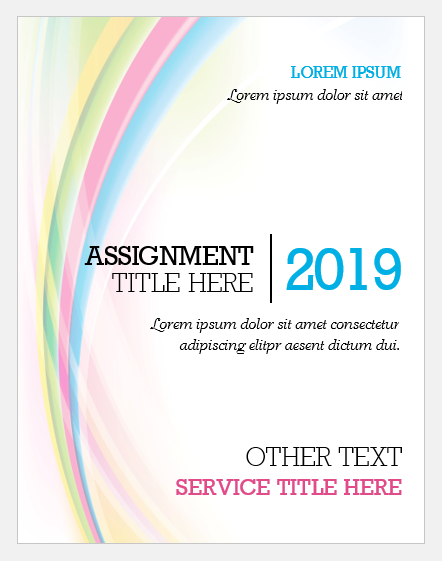
Assignment Cover Pages
Assignment cover page is the first page of an assignment. When you hold an assignment, the first page that you will see is the cover page. It is also called the title page. An assignment cover page includes the name of the institution, the title of the assignment, the name of the student, and the student’s ID. The assignment cover page helps identify what the assignment is about and which student submitted it.
Many students submit assignments to instructors, and instructors are usually teaching more than one subject. Therefore, without an assignment cover page, it would be difficult for the instructor to manage and sort out different assignments.
When there is an assignment cover page, instructors can easily sort out the assignments and grade them. Even the students submitting multiple assignments on the same day could end up submitting the wrong assignment if the assignments didn’t have a cover page.
Another important reason for having assignment cover pages is that this is part of training students to submit work professionally. An assignment cover page shows professionalism in submitting work. When students are trained for professional work, they are better equipped to succeed in their jobs. Thus, professors and instructors usually ask students to create cover pages for their assignments so that the students develop this habit early in their academic life.
The assignment cover page usually includes the name of the institution, title of the assignment, name of the student, student ID, and date of submission. In some cases, the title page may also mention the instructor’s name. Usually, the title page is not page-numbered.
Some courses might also require the students to format the assignment cover pages using popular referencing styles. For example, there is a particular format to make an assignment cover page using APA or MLA referencing styles.
In some cases, professors may also issue detailed instructions on how to format an assignment cover page. These instructions may include font style, font size, text color, page borders, and the information that must be stated on the cover page along with a particular order.
Cover pages are required in several situations:
- When submitting a project report
- When submitting a research proposal
- When submitting a dissertation
- When making a report that is longer than 2-3 pages
- When the assignment instructions require an assignment cover page
- When the professor is handling more than one subject assignments may be erroneously sorted
Assignment cover pages are very useful and can be created in MS Word or Adobe. MS Word software allows pictures and text to be used on the cover page. Students may also use headers and footers, page borders, and other features in MS Word to create a nice cover page. You can even use the popular heading styles given in MS Word.
If you do not have the time or energy to create a cover page, you may use cover pages available on our website. We offer editable cover page templates that you can easily download and customize. Browse through our specially designed assignment cover pages and save your time and effort.
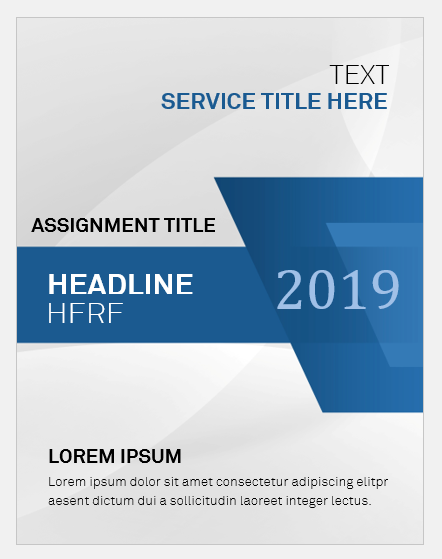
Editable with MS Word
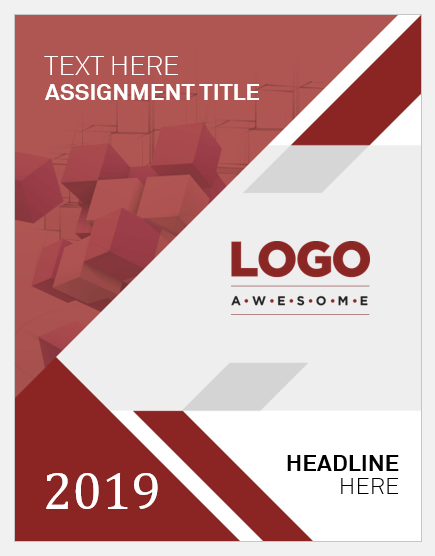
- Birthday Gift Card Templates
- Security Clearance Card Templates
- Parking Cards/Permits for Employees
- Company Meal Card Templates
- Conference Room Reservation Cards
- Employee Birthday Announcement Card Templates
- Happy Holiday Cards for Employees
- Good Luck Card Templates for Word
- Miscarriage Sympathy Cards
- Kids School ID Badge Templates
- Theater Ticket Templates for MS Word
- Service Dog ID Cards
- Service Dog ID Badge Templates
- Christmas Wish Cards in Editable Format
- Christmas Party Invitation Cards
Purdue Online Writing Lab Purdue OWL® College of Liberal Arts
Understanding Writing Assignments

Welcome to the Purdue OWL
This page is brought to you by the OWL at Purdue University. When printing this page, you must include the entire legal notice.
Copyright ©1995-2018 by The Writing Lab & The OWL at Purdue and Purdue University. All rights reserved. This material may not be published, reproduced, broadcast, rewritten, or redistributed without permission. Use of this site constitutes acceptance of our terms and conditions of fair use.
How to Decipher the Paper Assignment
Many instructors write their assignment prompts differently. By following a few steps, you can better understand the requirements for the assignment. The best way, as always, is to ask the instructor about anything confusing.
- Read the prompt the entire way through once. This gives you an overall view of what is going on.
- Underline or circle the portions that you absolutely must know. This information may include due date, research (source) requirements, page length, and format (MLA, APA, CMS).
- Underline or circle important phrases. You should know your instructor at least a little by now - what phrases do they use in class? Does he repeatedly say a specific word? If these are in the prompt, you know the instructor wants you to use them in the assignment.
- Think about how you will address the prompt. The prompt contains clues on how to write the assignment. Your instructor will often describe the ideas they want discussed either in questions, in bullet points, or in the text of the prompt. Think about each of these sentences and number them so that you can write a paragraph or section of your essay on that portion if necessary.
- Rank ideas in descending order, from most important to least important. Instructors may include more questions or talking points than you can cover in your assignment, so rank them in the order you think is more important. One area of the prompt may be more interesting to you than another.
- Ask your instructor questions if you have any.
After you are finished with these steps, ask yourself the following:
- What is the purpose of this assignment? Is my purpose to provide information without forming an argument, to construct an argument based on research, or analyze a poem and discuss its imagery?
- Who is my audience? Is my instructor my only audience? Who else might read this? Will it be posted online? What are my readers' needs and expectations?
- What resources do I need to begin work? Do I need to conduct literature (hermeneutic or historical) research, or do I need to review important literature on the topic and then conduct empirical research, such as a survey or an observation? How many sources are required?
- Who - beyond my instructor - can I contact to help me if I have questions? Do you have a writing lab or student service center that offers tutorials in writing?
(Notes on prompts made in blue )
Poster or Song Analysis: Poster or Song? Poster!
Goals : To systematically consider the rhetorical choices made in either a poster or a song. She says that all the time.
Things to Consider: ah- talking points
- how the poster addresses its audience and is affected by context I'll do this first - 1.
- general layout, use of color, contours of light and shade, etc.
- use of contrast, alignment, repetition, and proximity C.A.R.P. They say that, too. I'll do this third - 3.
- the point of view the viewer is invited to take, poses of figures in the poster, etc. any text that may be present
- possible cultural ramifications or social issues that have bearing I'll cover this second - 2.
- ethical implications
- how the poster affects us emotionally, or what mood it evokes
- the poster's implicit argument and its effectiveness said that was important in class, so I'll discuss this last - 4.
- how the song addresses its audience
- lyrics: how they rhyme, repeat, what they say
- use of music, tempo, different instruments
- possible cultural ramifications or social issues that have bearing
- emotional effects
- the implicit argument and its effectiveness
These thinking points are not a step-by-step guideline on how to write your paper; instead, they are various means through which you can approach the subject. I do expect to see at least a few of them addressed, and there are other aspects that may be pertinent to your choice that have not been included in these lists. You will want to find a central idea and base your argument around that. Additionally, you must include a copy of the poster or song that you are working with. Really important!
I will be your audience. This is a formal paper, and you should use academic conventions throughout.
Length: 4 pages Format: Typed, double-spaced, 10-12 point Times New Roman, 1 inch margins I need to remember the format stuff. I messed this up last time =(
Academic Argument Essay
5-7 pages, Times New Roman 12 pt. font, 1 inch margins.
Minimum of five cited sources: 3 must be from academic journals or books
- Design Plan due: Thurs. 10/19
- Rough Draft due: Monday 10/30
- Final Draft due: Thurs. 11/9
Remember this! I missed the deadline last time
The design plan is simply a statement of purpose, as described on pages 40-41 of the book, and an outline. The outline may be formal, as we discussed in class, or a printout of an Open Mind project. It must be a minimum of 1 page typed information, plus 1 page outline.
This project is an expansion of your opinion editorial. While you should avoid repeating any of your exact phrases from Project 2, you may reuse some of the same ideas. Your topic should be similar. You must use research to support your position, and you must also demonstrate a fairly thorough knowledge of any opposing position(s). 2 things to do - my position and the opposite.
Your essay should begin with an introduction that encapsulates your topic and indicates 1 the general trajectory of your argument. You need to have a discernable thesis that appears early in your paper. Your conclusion should restate the thesis in different words, 2 and then draw some additional meaningful analysis out of the developments of your argument. Think of this as a "so what" factor. What are some implications for the future, relating to your topic? What does all this (what you have argued) mean for society, or for the section of it to which your argument pertains? A good conclusion moves outside the topic in the paper and deals with a larger issue.
You should spend at least one paragraph acknowledging and describing the opposing position in a manner that is respectful and honestly representative of the opposition’s 3 views. The counterargument does not need to occur in a certain area, but generally begins or ends your argument. Asserting and attempting to prove each aspect of your argument’s structure should comprise the majority of your paper. Ask yourself what your argument assumes and what must be proven in order to validate your claims. Then go step-by-step, paragraph-by-paragraph, addressing each facet of your position. Most important part!
Finally, pay attention to readability . Just because this is a research paper does not mean that it has to be boring. Use examples and allow your opinion to show through word choice and tone. Proofread before you turn in the paper. Your audience is generally the academic community and specifically me, as a representative of that community. Ok, They want this to be easy to read, to contain examples I find, and they want it to be grammatically correct. I can visit the tutoring center if I get stuck, or I can email the OWL Email Tutors short questions if I have any more problems.

Assignment Front Page Format, Design, and PDF File
Today we are sharing the assignment first page format for schools and college students. This format very useful for students for their assignment submission in school, college and university. You can also download this assignment front page design in word file format.
Note: There is a no specific and pre-defined format for assignment cover page. The front page of assignment define by school, college, university, etc. But there is general format for assignment submission which is use globally. You can change or modified this format according to you.

1. Assignment Front Page Format
2. Assignment Cover Page Design
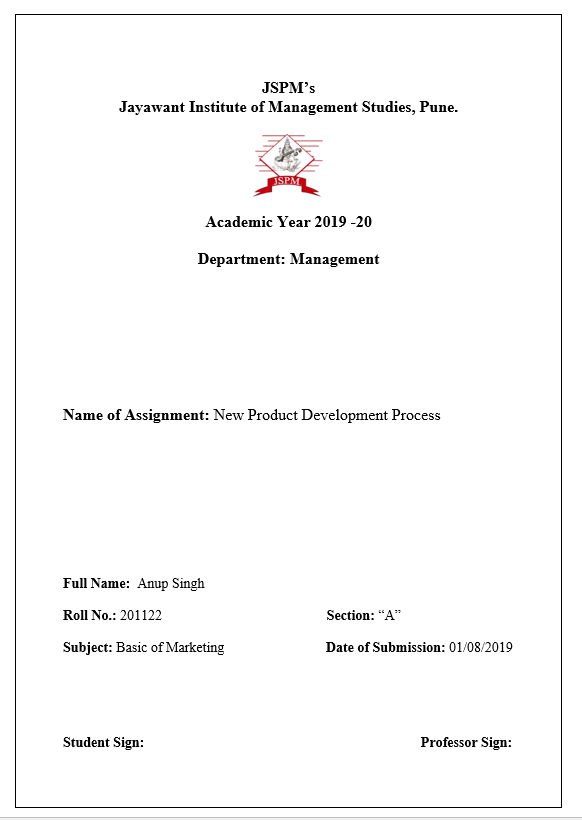
3. Download Assignment Design PDF & Word File
Here you can download the assignment front page format in word download. You can easily download assignment design file and edit it as per your need. You can also find this files in your Microsoft Office. Choose you best assignment front page design and impress your teachers or professors.
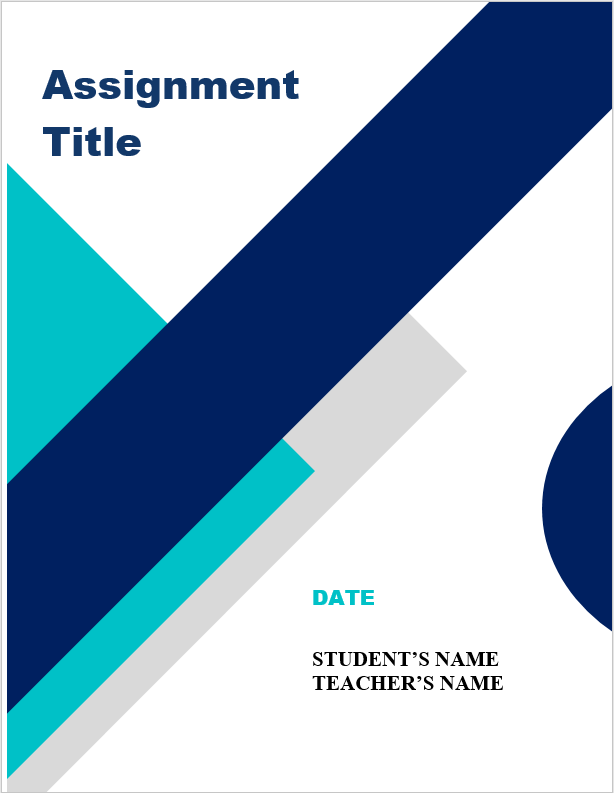
Source File & Credit: Microsoft Office
Use Microsoft Word to edit this file. You can easily edit this file in Microsoft Office. Replace the file with your college name, logo, etc.
Assignment is a very crucial part in academic. Your project report front page or assignment first page design play an important role like first impression is last impression. If you impress your processor or teacher then you will score good mark.
See More: General Topics for Presentation

IMAGES
VIDEO
COMMENTS
1. Margins: Leave one-inch margins on all sides of your cover page to give it a neat look and provide space for your text. 2. Font: Stick to Times or Times New Roman font in 12 pt size for a professional appearance that's easy to read. 3. Spacing: Double-space the text on your cover page to make it clear and readable.
1 On the first line of the page, write the first student's name. 2 If there are other authors, write each name on its own line after the first. 3 On the line after the final author, write the name of the instructor. You don't need to include their full name, but it's best to use their title, such as "Professor Green.".
Customize your cover page quickly and easily. You don't need any design skills. No Photoshop skills. Just choose a template from this article or from the final waterfall and customize it to your liking. Writing first and last names, numbers, additional information or texts will be as easy as writing in a Word document.
Step 2: Guidelines On Font Spacing And Margins. Follow these standards ensures a clean and professional appearance for your assignment's first page: Font Style and Size: Use a readable font style like Times New Roman, Arial, or Calibri. Typical font size is 12 points for the main text.
Title Page Elements • The affiliation consists of the department of the course and the name of the university. • Write the course number and name and instructor name as shown on course materials. • Use the date format used in your country for the assignment due date. • Page number 1 appears in the top right of the page in the page header.
Use the rest of the assignment to showcase your knowledge and leave the first page clean and straightforward. Inconsistency - Use the same font, size, and spacing throughout your assignment. Consistency is key to a professional look. Ignoring Guidelines - Always read and follow any guidelines or templates provided by your instructor or institution.
Assignment due date. Page number 1 in the top right corner of the page header. ... Write the title page using the same font and font size as the rest of your paper. Bold the paper title. ... Bold the "References" label at the top of the first page of references. Use italics within reference list entries on either the title (e.g., webpages ...
An assignment cover simply marks the first page of any assignment. Whenever you prepare an assignment the front page here is termed as the most focussed part. This includes the name of the institute, the Title, the student's respective name, and the ID. ... The font size used for writing the name must be bigger so that it makes the name ...
Cover pages can include the name of your school, your paper title, your name, your course name, your teacher or professor's name, and the due date of the paper. If you are unsure of what to include, check with your instructor. Here is an example of a cover page in MLA format: For more help making cover or title pages, visit our title page ...
To design a cover page for an English project, you can consider the following steps: Choose a theme that aligns with the project topic and make it visually appealing. Add a title that clearly represents the project, it should be big and legible. Add your name, class, and date in a clear and concise manner.
The main details that should be added to the assignment's front page are: Title of the subject. Topic of assignment. Name of teacher. Name and roll number of students. The registration number of students. Department in which the student is enrolled. The assignment's front page should be made with great care.
The front page of your assignment file is as important as any other section of it. Although creating the front page is a simple step of the assignment writing process many times students do not pay much attention to its formatting and presentation. If created well, the assignment cover can surely put a great impact on your instructors and readers.
Planning your assignment carefully and presenting arguments step-by-step is necessary to succeed with your homework. When going through your references, note the questions that appear and answer them, building your text. Create a cover page, proofread the whole text, and take care of formatting.
Follow the guidelines described next to format each element of the student title page. Place the title three to four lines down from the top of the title page. Center it and type it in bold font. Capitalize major words of the title. Place the main title and any subtitle on separate double-spaced lines if desired.
Instructors can often help students write more effective papers by giving students written instructions about that assignment. Explicit descriptions of assignments on the syllabus or on an "assignment sheet" tend to produce the best results. These instructions might make explicit the process or steps necessary to complete the assignment.
The student version of the APA title page should include the following information (double spaced and centered): Paper title. Author name. Department and university name. Course number and name. Instructor name. Due date of the assignment. The professional title page also includes an author note (flushed left), but not a course name, instructor ...
Download. Download. These are the essential things that should be written on first page of your assignment whether it be a business-related assignment or biological sciences one. Every assignment cover page tends to follow the same pattern mentioned above. A well-managed and organised individual will not overlook these points as he knows the ...
An assignment cover page includes the name of the institution, the title of the assignment, the name of the student, and the student's ID. The assignment cover page helps identify what the assignment is about and which student submitted it. Many students submit assignments to instructors, and instructors are usually teaching more than one ...
How to prepare assignment ||Front page design||Crazy skillsHow to make assignment ||Front page design||[drawing][calligraphy]in this video i have made assign...
Many instructors write their assignment prompts differently. By following a few steps, you can better understand the requirements for the assignment. The best way, as always, is to ask the instructor about anything confusing. Read the prompt the entire way through once. This gives you an overall view of what is going on.
Your project report front page or assignment first page design play an important role like first impression is last impression. If you impress your processor or teacher then you will score good mark. ... Recent Posts. Top Article Writing Topics to Inspire Creativity; 2 Minute Speech Topics & Ideas 2024; 10 Minute Presentation Topics And Ideas ...